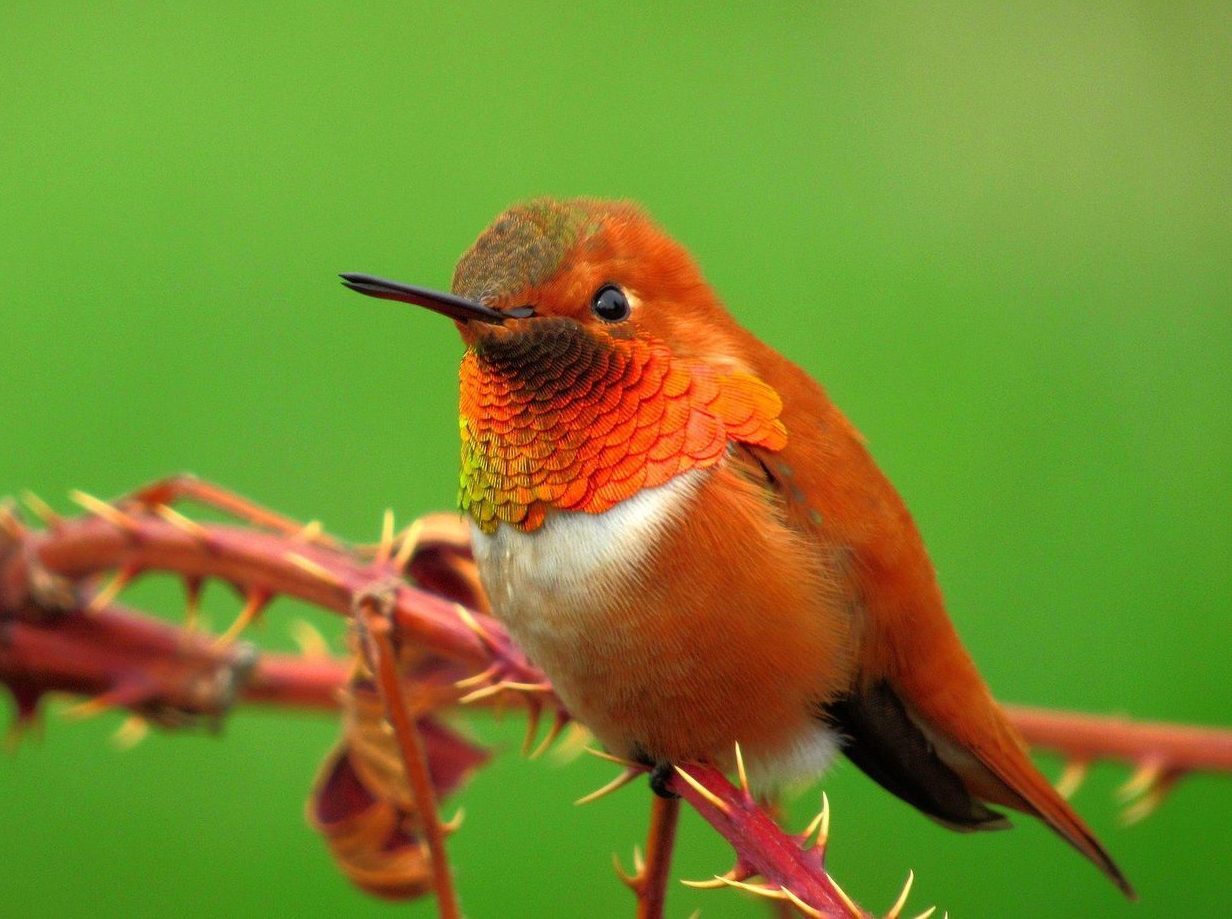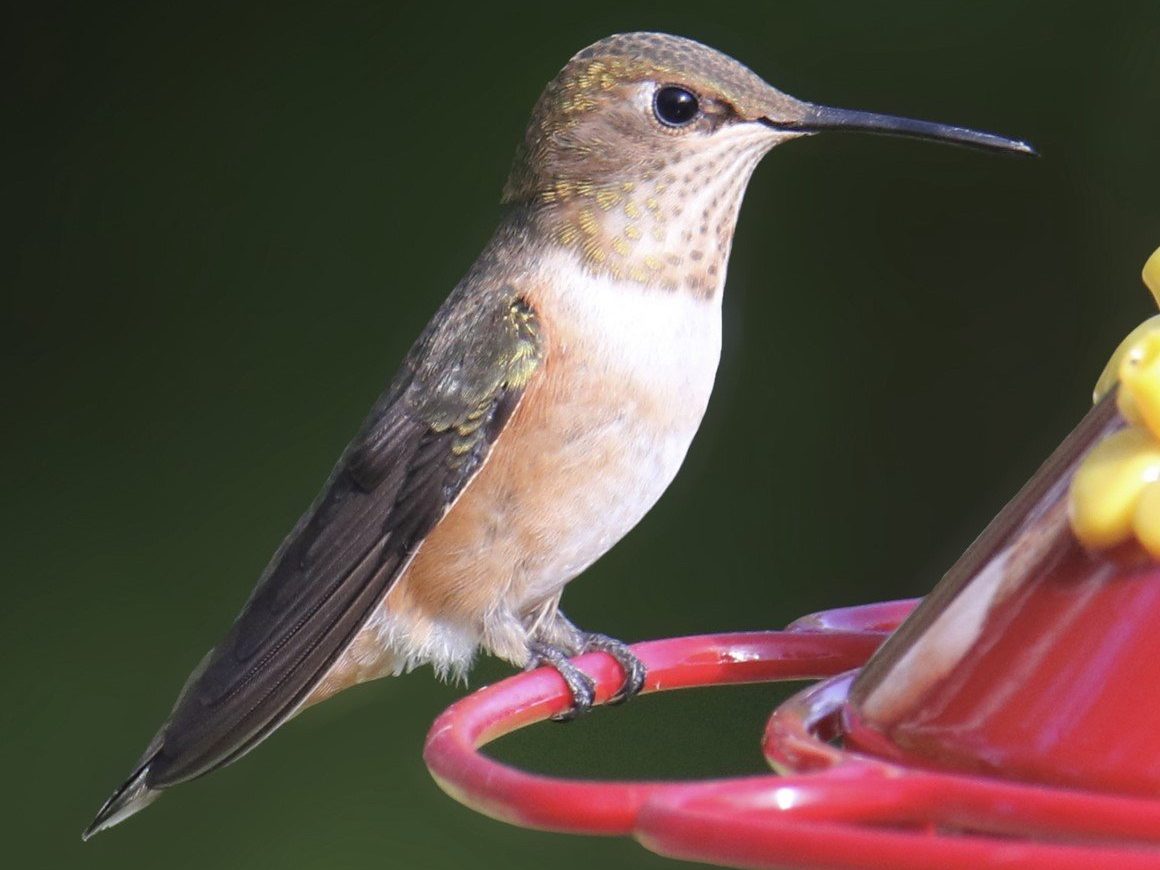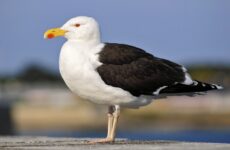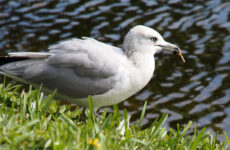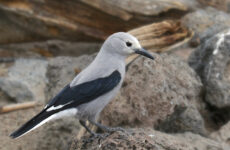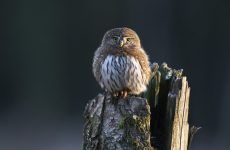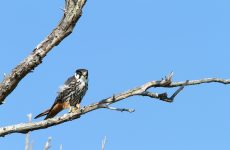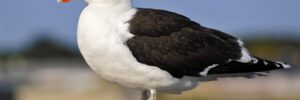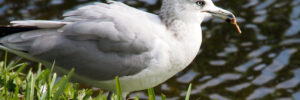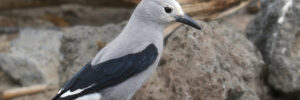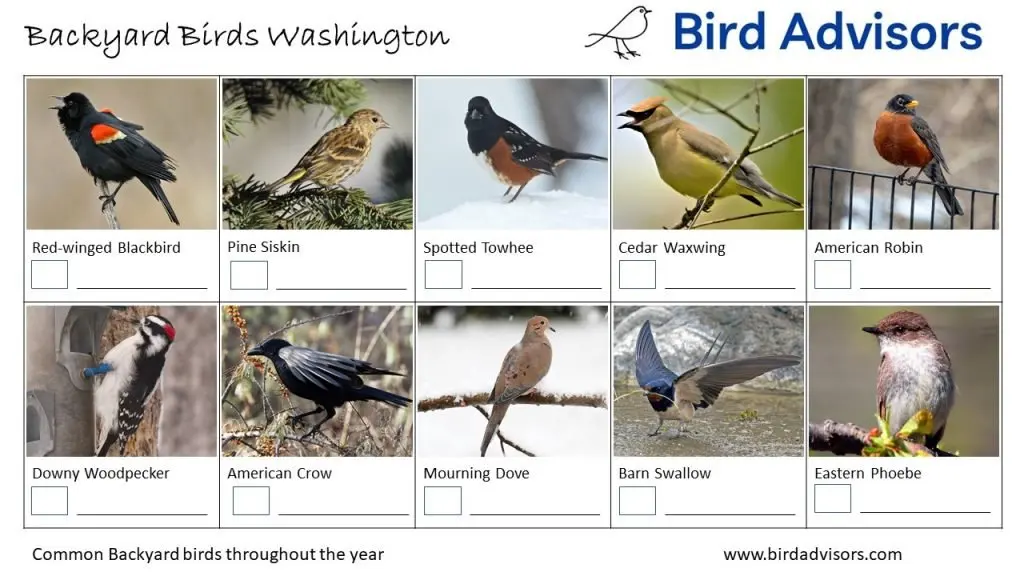
Have you wondered what those birds are that are visiting your backyard in Washington?
Well, this guide will help you to find out how to identify these birds by sight and sound and what time of year you can spot them in Washington. Also, get a free ID chart to print with the most common backyard birds in Washington.
In Washington American Goldfinches and Barn Swallows are more common in summer and Dark-eyed Juncos and Anna’s Hummingbirds are more common in winter.
Backyard birds in Washington all year: American Robin, Song Sparrow, American Crow, Spotted Towhee, Black-capped Chickadee, Dark-eyed Junco, European Starling, Northern Flicker, White-crowned Sparrow, House Finch, Red-winged Blackbird, Anna’s Hummingbird, Chestnut-backed Chickadee, Steller’s Jay, Red-breasted Nuthatch, House Sparrow, Yellow-rumped Warbler, Pine Siskin, Golden-crowned Kinglet, Downy Woodpecker, Mourning Dove, Eurasian Collared-Dove, Hairy Woodpecker
Backyard birds in Washington in summer: American Goldfinch, Barn Swallow, Cedar Waxwing, Swainson’s Thrush, Rufous Hummingbird, Purple Finch, Common Yellowthroat
Backyard birds in Washington in winter: Golden-crowned Sparrow, Ruby-crowned Kinglet
These are the most common backyard birds in Washington that may visit your lawn or feeders. They are the birds that appear most frequently on state checklists submitted by bird watchers on ebird.
This article gives you identification information and photos to help you identify and attract more of the common backyard birds that you can spot in Washington.
If you like backyard birding you will probably enjoy spotting some ducks in Washington too.
Birds Facts for Washington
The American Goldfinch is the state bird of Washington. This bird was voted in by school children in 1951 after there were 2 state birds previously selected. Previously, school children chose the meadowlark in 1929, but as it was already so popular with other states, a new choice was made. The goldfinch was selected in 1931 by Washington’s Federation of Women Clubs, so then there were two birds.
There are 511 species of bird recorded in Washington, according to ebird. Some of the highlight birds in Washington are Great Blue Heron, Bald Eagle, Double-crested Cormorant, Belted Kingfisher, Osprey, Turkey Vulture, Short-eared Owl, Tufted Puffin, Western Tanager, Harlequin Ducks, Brown Pelicans, Sandhill Crane.
The biggest bird in Washington is the Bald Eagle, with a wingspan of up to 8 feet (2.5 m) for the females. This white-headed national bird symbol of the United States is a powerful bird of prey.
The most common bird in Washington is the American Robin, which is seen in 45% of recorded checklists for the state on ebird throughout the year.
Washington has 3 national parks, 5 national forests, 23 national wildlife refuges, and 100 state parks that offer excellent bird watching opportunities if you want to get out and watch birds in their natural environment.
Read to the end of this article to find out more about the other birds you may be able to spot if you go out birding in Washington and how to attract and identify birds.
Free Printable Backyard Birds Worksheet for Washington
These free bird identification worksheets have all the common backyard birds in Washington at different times of the year. So when you want to do some backyard birding, these handy guides have pictures and space to either tick off the types of birds you have seen or keep a bird tally of the total number of birds.

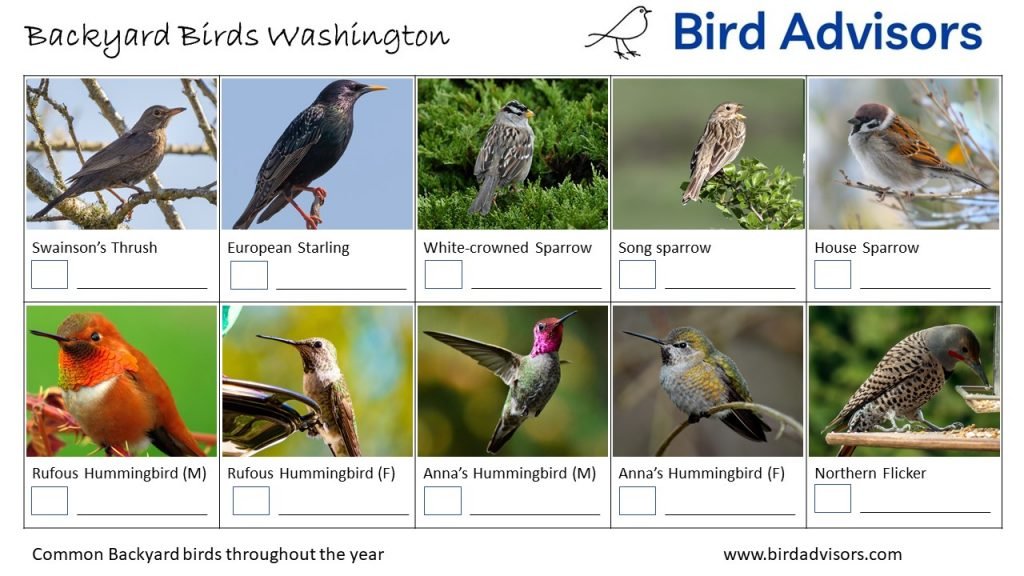

32 Common Backyard Birds In Washington
1. American Robin
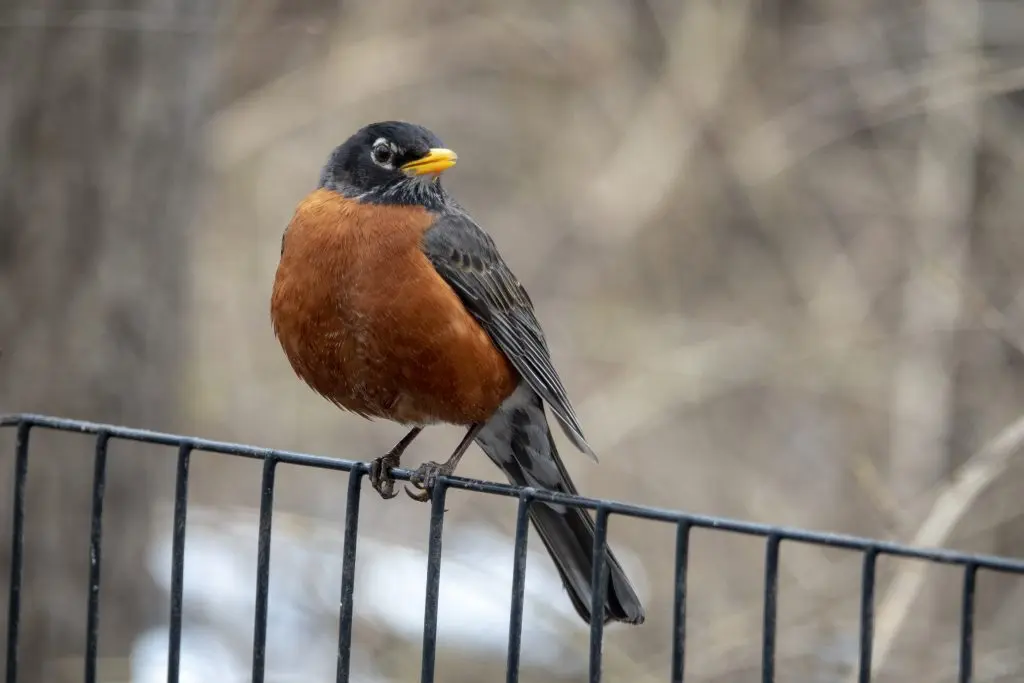
American Robins are spotted all year in Washington but are more common from March to July. They appear in 60% of summer checklists and 33% of winter checklists submitted by bird watchers for the state.
American Robins are a common sight on lawns eating earthworms. They have black heads and backs with red or orange breasts. They tend to roost in trees in winter, so you are more likely to see them in your backyard from spring.
- Turdus migratorius
- Length: 7.9-11.0 in (20-28 cm)
- Weight: 2.7-3.0 oz (77-85 g)
- Wingspan: 12.2-15.8 in (31-40 cm)
American Robins are residents in the lower 48 and the coast of Western Canada and Alaska. Those that breed in Canada and inland Alaska move south for the winter.
American Robins can be found in many habitats, from woodlands, forests, and mountains to fields, parks, and lawns. They eat earthworms, insects, snails, and fruit.
American Robin Song:
American Robin Call:
Attract American Robins to your backyard with sunflower seeds, suet and peanut hearts, fruit, and mealworms. Platform feeders are best or food scattered on the ground. Also, try planting some native plants that produce berries, such as juniper, sumac, hawthorn, and dogwood.
2. Song Sparrow
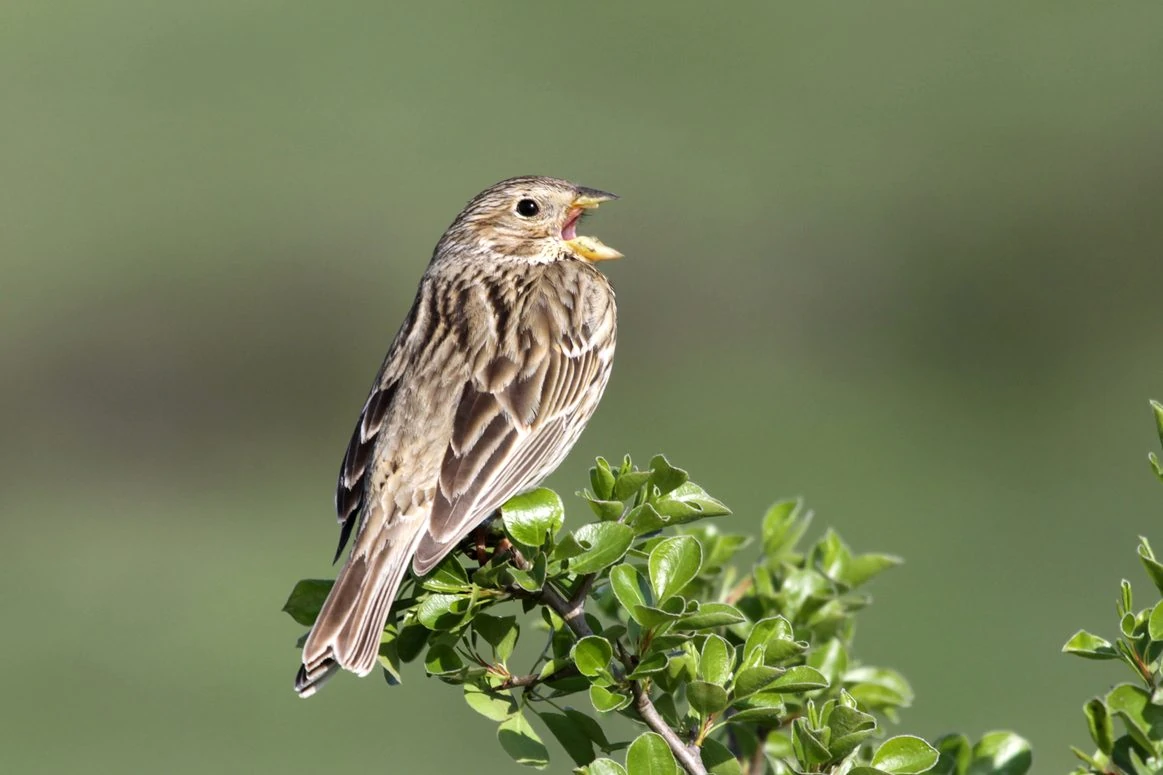
Song Sparrows are spotted in Washington all year and are recorded in 44% of summer and winter checklists submitted by bird watchers for the state.
Song sparrows are not as remarkable looking as other backyard birds, but these predominantly brown-streaked birds use their almost constant song to attract mates in spring and summer.
- Melospiza melodia
- Length: 4.7-6.7 in (12-17 cm)
- Weight: 0.4-1.9 oz (12-53 g)
- Wingspan: 7.1-9.4 in (18-24 cm)
Song Sparrows live all year in the northern US states. Those that breed in Canada migrate to southern US states for winter.
They can be found in open, shrubby, and wet areas, often perched on a low shrub singing. They are often found at backyard feeders.
Song Sparrows eat a wide variety of insects and plants, including beetles, caterpillars, midges, spiders, and earthworms. They will also eat buckwheat, sunflower, raspberries, wild cherries, blackberries, wheat, and rice.
Song Sparrow Song:
Song Sparrow Call:
Attract Song Sparrows to your backyard feeders by putting black oil sunflower seeds, cracked corn, and nyjer on platform feeders.
Sparrows are known as LBJs (Little brown jobs) but if you want to know more, check out this guide to sparrows in Washington.
3. American Crow
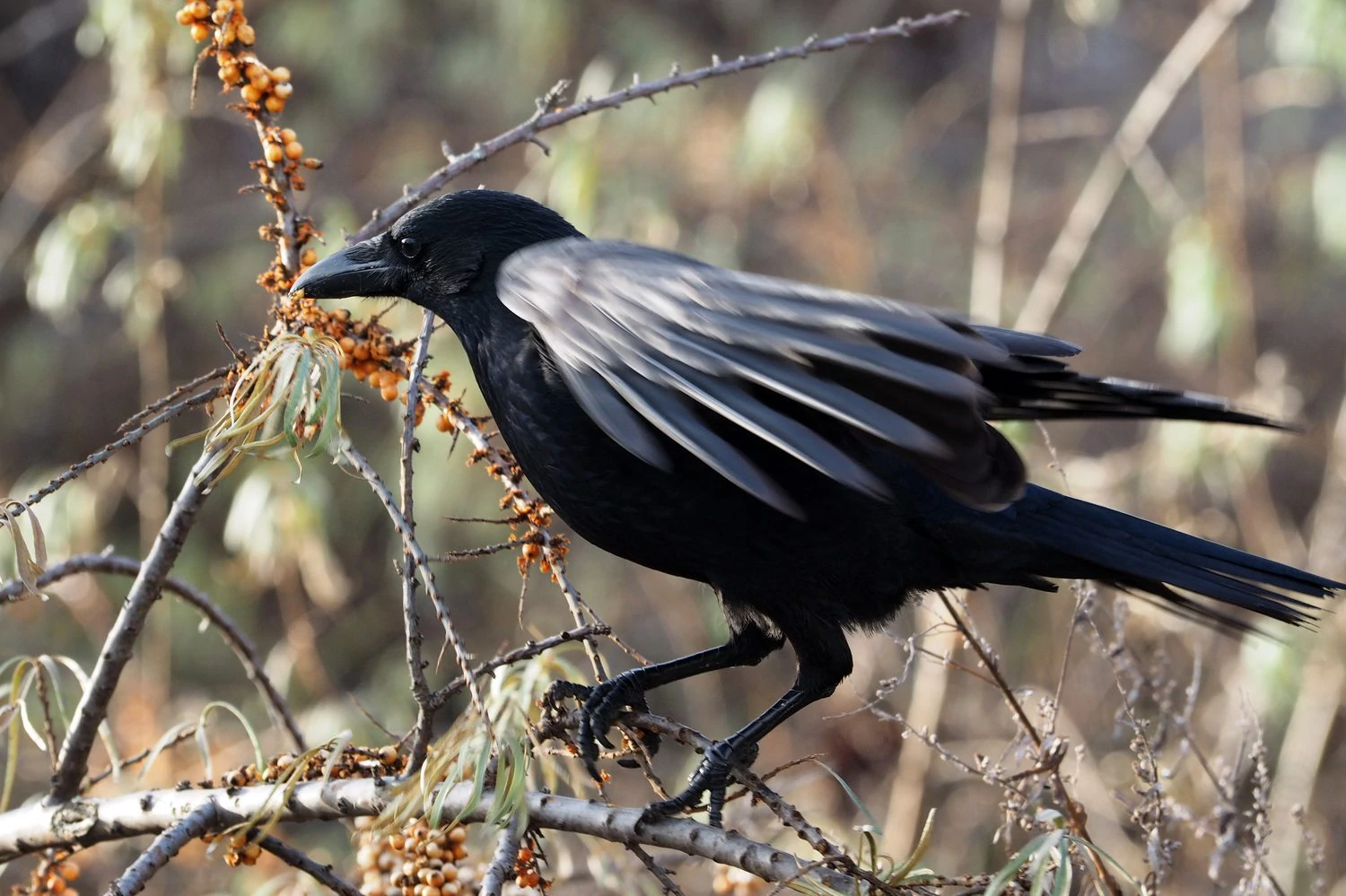
American Crows live in Washington all year, especially in the west of the state. They are recorded in 44% of summer checklists and 42% of winter checklists.
American crows are large all-black birds that make a hoarse, cawing sound.
- Corvus brachyrhynchos
- Length: 15.8-20.9 in (40-53 cm)
- Weight: 11.2-21.9 oz (316-620 g)
- Wingspan: 33.5-39.4 in (85-100 cm)
American Crows are residents all year in most of the lower 48 and the Pacific Coast in Canada and Alaska. Those that breed in Canada and the northern Midwest migrate south for winter.
They are common birds found in most habitats, including treetops, woods, fields, beaches, or towns.
They eat most things and usually feed on the ground, eating earthworms, insects, seeds, and fruit. They also eat fish, young turtles, mussels, and clams and will even eat eggs and nestlings of many species of birds.
In winter, American Crows gather in large numbers of up to two million crows to sleep in noisy communal roosts.
American Crow Call:
Attract American Crows to your backyard by scattering peanuts, but they can become a nuisance as they are attracted by garbage or pet food if left out.
4. Spotted Towhee
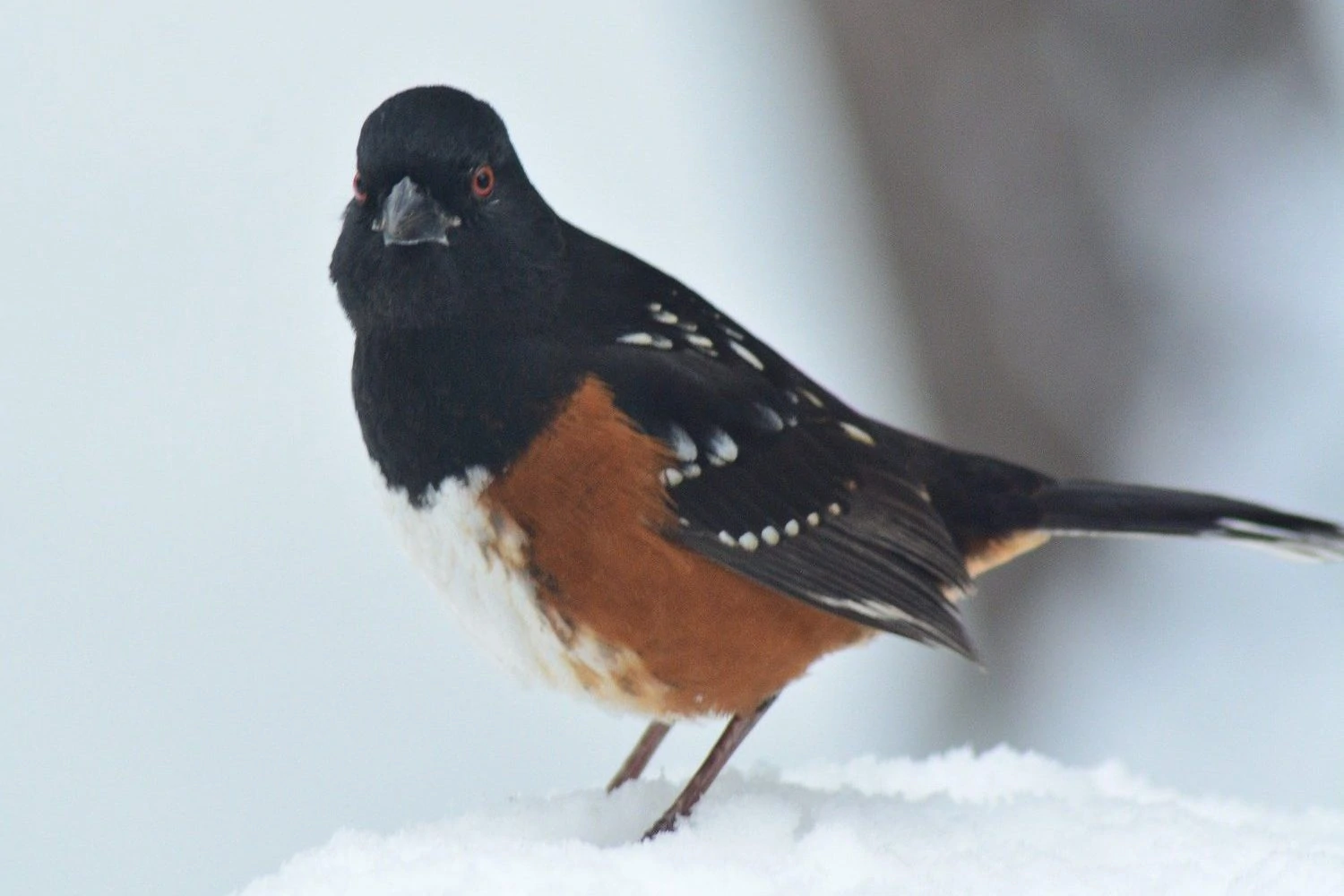
Spotted Towhees can be spotted in western Washington all year, but they only spend the breeding season in the east of the state. They are recorded in around 30% of summer and winter checklists.
Spotted Towhees are large sparrows that are black on their head, throat, and back in the males and brown in the females. Both males and females have reddish-brown sides, white bellies, and white spots on the wings and back. They have long tails and are about the size of a Robin.
- Pipilo maculatus
- Length: 6.7-8.3 in (17-21 cm)
- Weight: 1.2-1.7 oz (33-49 g)
- Wingspan: 11.0 in (28 cm)
Spotted Towhees live in western US states, but those in the interior of the north migrate south after breeding to Texas and surrounding areas.
You can find Spotted Towhees on the ground in dense tangles of shrubs scratching around for insects, including beetles, crickets, grasshoppers, caterpillars, wasps, and bees. They also eat acorns, berries, and seeds.
Spotted Towhee Song:
Attract Spotted Towhees to your yard if you leave overgrown borders, and they will visit platform feeders or ground feeders for black oil sunflower seeds, hulled sunflower seeds, cracked corn, millet, and milo.
5. American Goldfinch
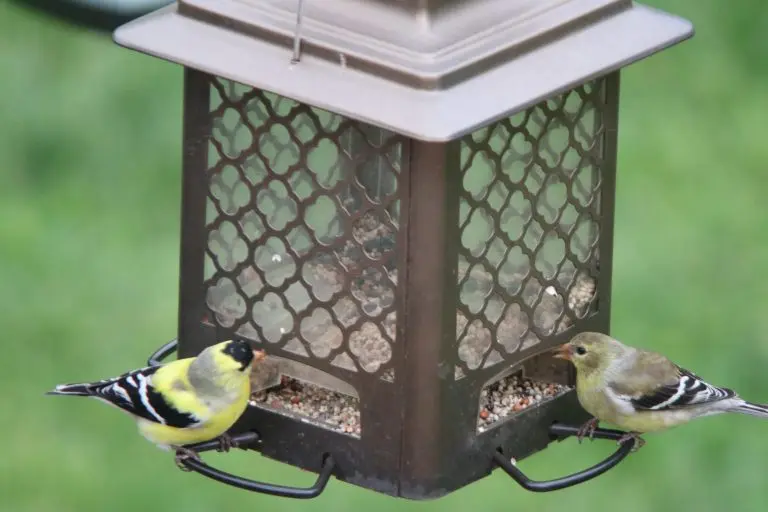
American Goldfinches spend the breeding season in western Washington, but they also remain in the east of the state all year. They are recorded in 31% of summer checklists and 9% of winter checklists submitted by bird watchers for the state.
American Goldfinches are popular birds with the males’ bright yellow and black coloring in spring. The females are duller brown, as are males in winter.
- Spinus tristis
- Length: 4.3-5.1 in (11-13 cm)
- Weight: 0.4-0.7 oz (11-20 g)
- Wingspan: 7.5-8.7 in (19-22 cm)
American Goldfinches can be found in most of North America and are usually resident all year. However, those that breed in Canada and the Midwest migrate to southern US States for winter.
They can be found in weedy fields and overgrown areas foraging for sunflower, thistle, and aster plants. They are also common in suburbs, parks, and backyards.
American Goldfinch Song:
Attract American Goldfinches to your backyard by planting thistles and milkweed. They will visit most bird feeders and prefer sunflower seed and nyjer seed.
There are so many yellow birds in Washington that you will spot, especially in spring.
6. Black-capped Chickadee
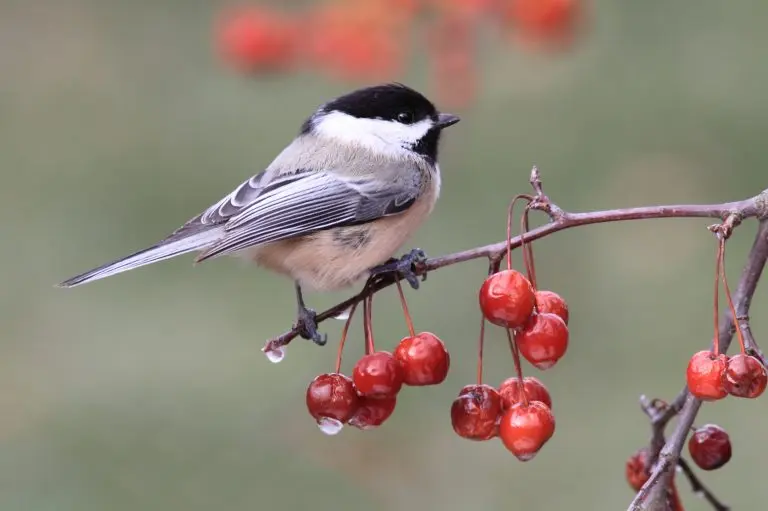
Black-capped Chickadees are residents of Washington all year. They do not migrate and occur in 30% of summer checklists and 38% of winter checklists.
The Black-capped Chickadee is a cute bird with a big round head and tiny body. These birds will happily feed at backyard feeders and investigate everything, including you!
They have black caps and beaks, white cheeks, and are gray on the back, wings, and tail.
- Poecile atricapillus
- Length: 4.7-5.9 in (12-15 cm)
- Weight: 0.3-0.5 oz (9-14 g)
- Wingspan: 6.3-8.3 in (16-21 cm)
Black-capped Chickadees do not migrate and can be spotted in the northern half of the US and Canada.
You can find them in forests, open woods, and parks. Black-capped Chickadees eat seeds, berries and insects, spiders, and suet.
Black-capped Chickadee Call/Song:
Attract Black-capped Chickadees to your backyard with suet, sunflower seeds, and peanuts or peanut butter. They will even feed from your hand and are often one of the first birds to discover new feeders. They will also use nest boxes, especially if you fill them with wood shavings.
You should find out all about the other sociable and inquisitive chickadees in Washington.
7. Barn Swallow
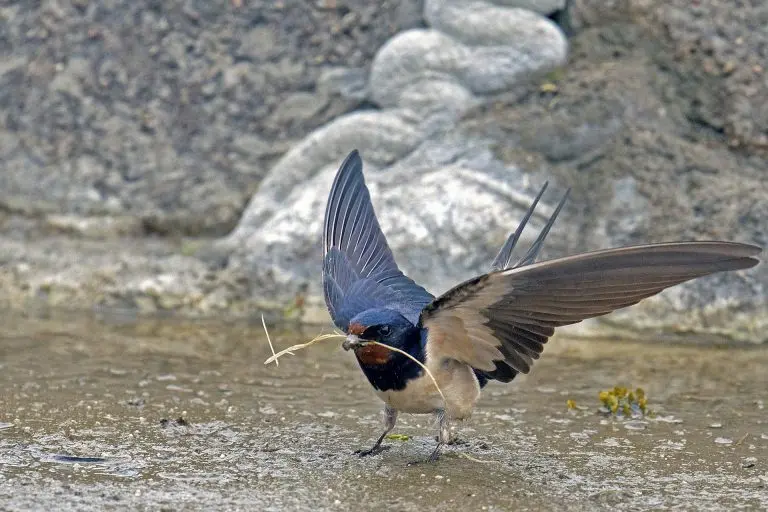
Barn Swallows spend the breeding season in Washington and are mainly spotted from April to October. However, a few hang around all year. They are recorded in 28% of summer checklists.
Barn Swallows are small birds with a deep-blue back, wings and tail, and reddish-brown underneath and across the face. Their tail has long outer feathers that give a deep fork. The dark color of their back can make them look black-and-white.
- Hirundo rustica
- Length: 5.9-7.5 in (15-19 cm)
- Weight: 0.6-0.7 oz (17-20 g)
- Wingspan: 11.4-12.6 in (29-32 cm)
Barn Swallows breed in Canada and the US before heading to Central and South America. They can be found flying over meadows, farms, and fields looking for insects and usually build mud nests on man-made structures such as barns.
Barn Swallow Call:
Attract Barn Swallows by putting up nest boxes or cups, and they may eat ground-up eggshells on a platform feeder.
8. Dark-eyed Junco
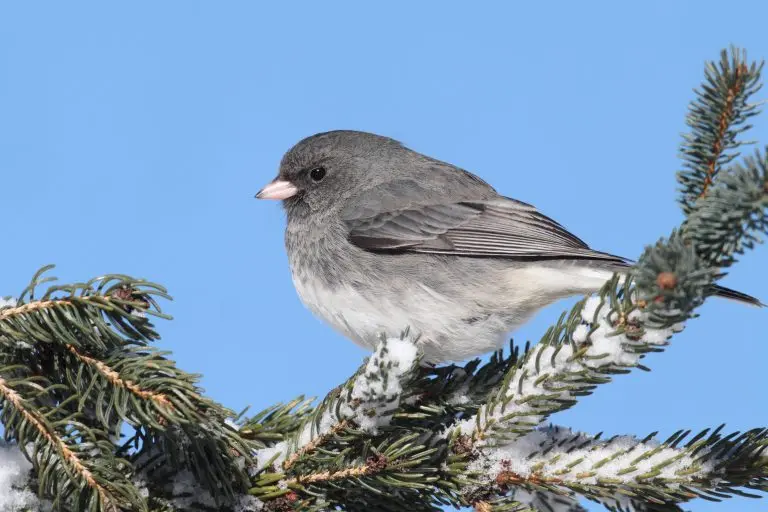
Dark-eyed Juncos can be spotted all year in Washington, but they are more often seen during winter, in the east of the state, from October to March. They appear in 30% of summer checklists and 46% of winter checklists.
Dark-eyed Juncos are sparrows that are different colors depending on the state. They are generally slate-colored in the east and black, white, and brown in the west.
- Junco hyemalis
- Length: 5.5-6.3 in (14-16 cm)
- Weight: 0.6-1.1 oz (18-30 g)
- Wingspan: 7.1-9.8 in (18-25 cm)
Dark-eyed Juncos remain resident all year in northeastern and western US states and the Appalachian Mountains. Those that breed in Canada and Alaska migrate south in winter to the United States.
They can be found in open and partially wooded areas, often on the ground, and are common across the continent.
Dark-eyed Junco Song:
Attract Dark-eyed Juncos to backyard feeders with a variety of seeds such as black oil sunflower seeds, nyjer, cracked corn, millet, and peanuts. Platform feeders or scattered on the ground is best.
9. European Starling
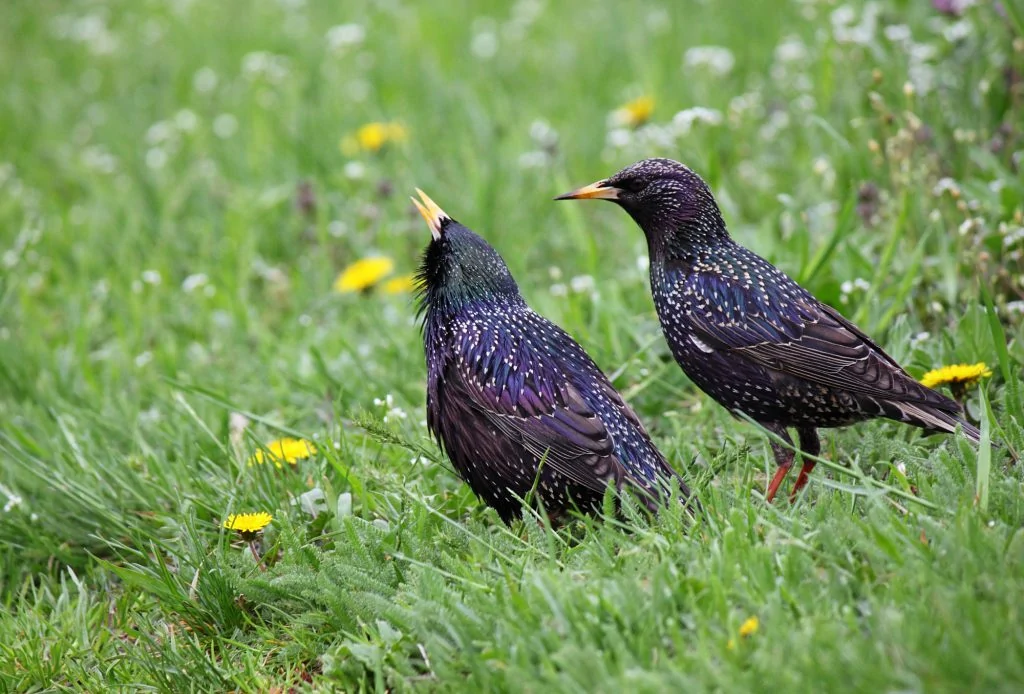
European Starlings are an introduced species in Washington and can be seen in the state all year. They appear in 31% of summer checklists and 27% of winter checklists submitted by bird watchers for the state.
European Starlings are not native but are now one of the most numerous songbirds. They are stocky black birds with iridescent purple, green, and blue tones.
- Sturnus vulgaris
- Length: 7.9-9.1 in (20-23 cm)
- Weight: 2.1-3.4 oz (60-96 g)
- Wingspan: 12.2-15.8 in (31-40 cm)
European Starlings live in all of North America, except the north of Canada and Alaska.
They are considered a pest by some due to their aggressive behavior. These birds fly in large, noisy flocks and can be seen perched in groups on the top of trees or flying over fields.
European Starling Calls:
Starlings predominantly eat insects, including beetles, flies and caterpillars, earthworms, and spiders. However, they also eat fruit, including cherries, holly berries, mulberries, Virginia Creeper, sumac, blackberries, and grains and seeds.
Attract European Starlings to your backyard feeders with black oil sunflower seeds, suet, cracked corn, and peanuts.
10. Northern Flicker
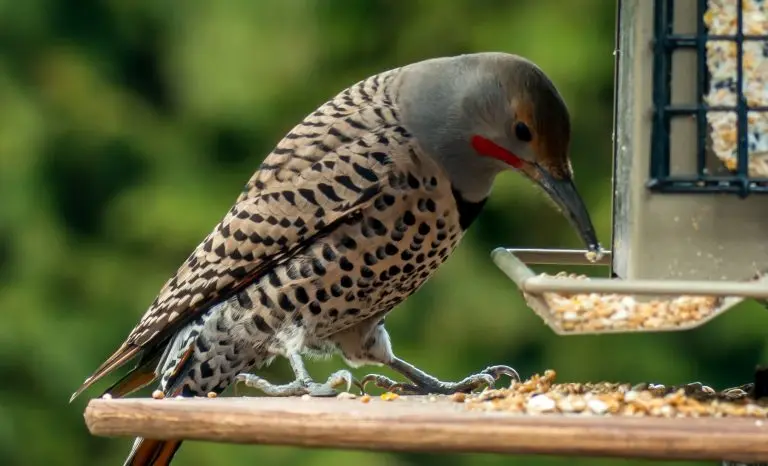
Northern Flickers are frequently spotted in Washington all year. They are recorded in 27% of summer checklists and 32% of winter checklists.
Northern Flickers are large brown woodpeckers with black spots and a white patch on their rump in flight, plus a red nape of the neck in the males.
Northern Flickers have red or yellow flashes in the wings and tail depending on where they originate. Red-shafted birds live in the west, and yellow-shafted birds live in the east.
- Colaptes auratus
- Length: 11.0-12.2 in (28-31 cm)
- Weight: 3.9-5.6 oz (110-160 g)
- Wingspan: 16.5-20.1 in (42-51 cm)
Northern Flickers can be spotted across the US all year and in Canada during summer. Those that breed in Canada migrate south for the winter.
Northern Flickers mainly eat ants, beetles, fruits, and seeds, and they can often be seen on the ground digging with their curved bill.
Northern flicker Call:
Attract Northern Flickers to your backyard with suet.
11. White-crowned Sparrow
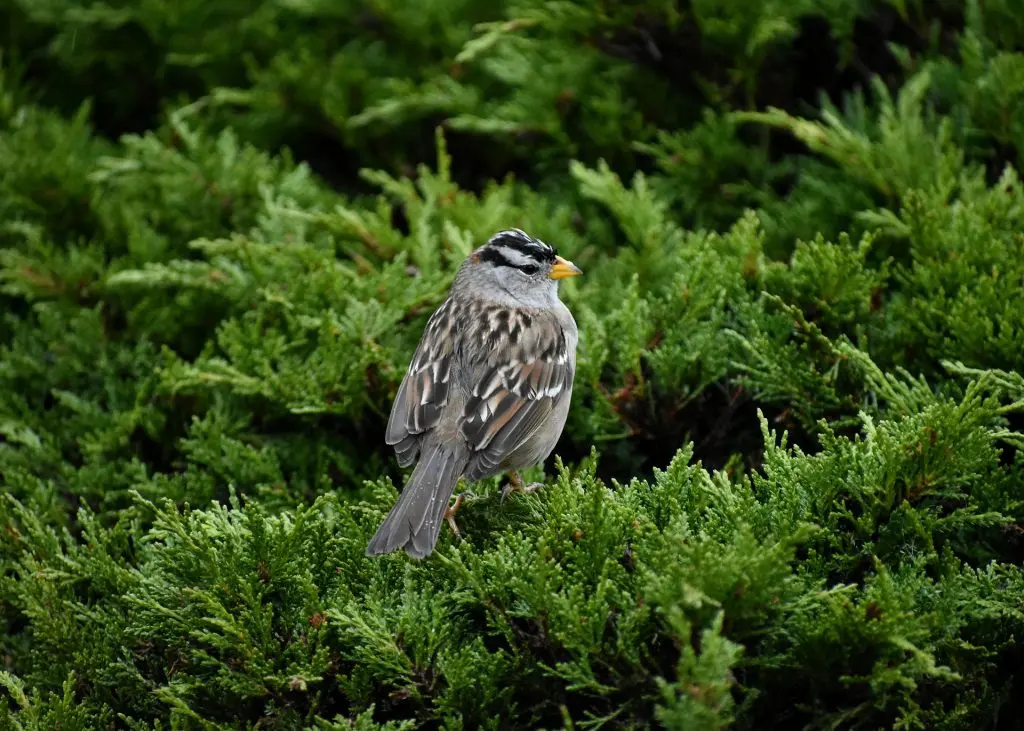
White-crowned Sparrows breed in western Washington, and some spend the winter in the southeast of the state. However, their numbers increase during the migration in April and September across the whole state.
They are spotted in around 24% of checklists in summer, 9% of checklists in winter but up to 43% during the migration.
White-crowned Sparrows are large grayish sparrows with long tails, small bills, and bold black and white stripes on their heads.
- Zonotrichia leucophrys
- Length: 5.9-6.3 in (15-16 cm)
- Weight: 0.9-1.0 oz (25-28 g)
- Wingspan: 8.3-9.4 in (21-24 cm)
White-crowned Sparrows breed in Alaska and arctic Canada before heading south to the lower 48 and Mexico for winter. However, some may remain along the Pacific Coast and the mountainous west all year.
You can find White-crowned Sparrows in weedy fields, along roadsides, forest edges, and in yards foraging for seeds of weeds and grasses or fruit such as elderberries and blackberries.
White-crowned Sparrow Song:
Attract White-crowned Sparrows to your backyard with sunflower seeds, and they will also eat seeds that other birds drop at feeders.
12. House Finch
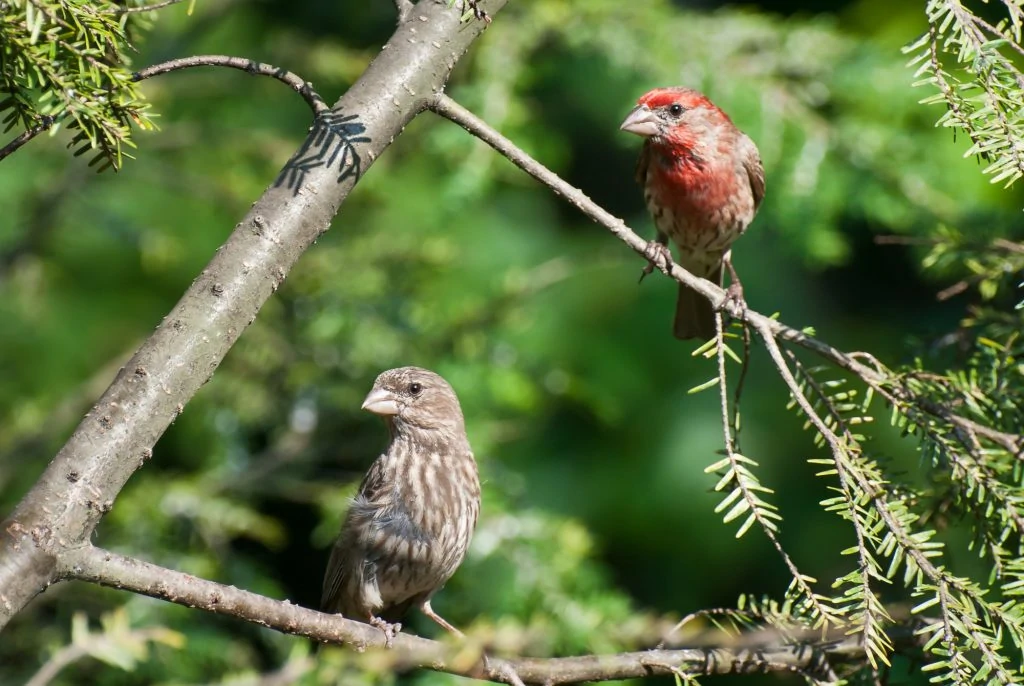
House Finches are residents of Washington all year. They do not migrate and appear in 26% of summer checklists and 23% of winter checklists submitted by bird watchers for the state.
House Finches males have a red head and breast, and the rest of their bodies are mainly brown-streaked. Females are brown-streaked all over.
- Haemorhous mexicanus
- Length: 5.1-5.5 in (13-14 cm)
- Weight: 0.6-0.9 oz (16-27 g)
- Wingspan: 7.9-9.8 in (20-25 cm)
Originally only in western US states, House Finches were introduced to eastern US states and have done very well, even pushing out the Purple Finch.
They can be found in parks, farms, forest edges, and backyard feeders in noisy groups that are hard to miss.
House Finch Song:
House Finch Call:
Attract House Finches to backyard feeders with black oil sunflower seeds or nyjer seeds in tube feeders or platform feeders.
There are lots of other red birds in Washington that you can spot.
13. Cedar Waxwing
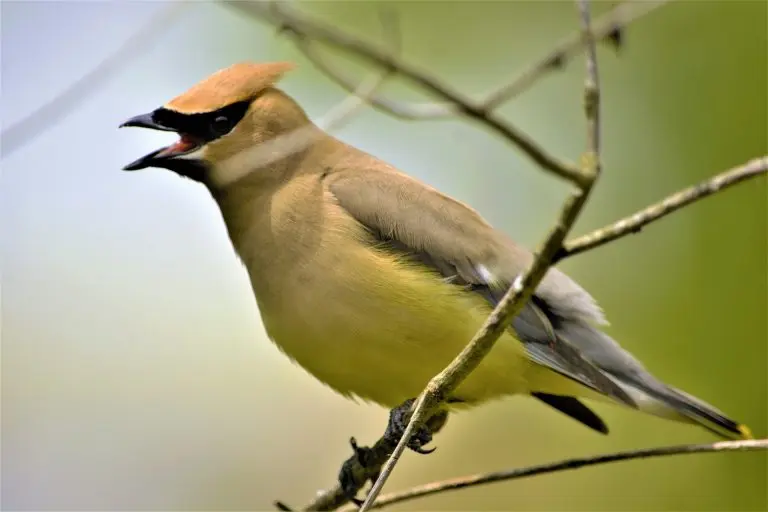
Cedar Waxwings are mainly seen in Washington during the breeding season, but some also remain here all year. They are recorded in 19% of summer checklists and 1% of winter checklists.
Cedar Waxwings are elegant social birds that are pale brown on the head, chest, and crest, which fades to gray on the back, wings, and tail.
Their belly is pale yellow and bright yellow towards the tail. They have a narrow black mask over their eyes and bright red on the wingtips.
- Bombycilla cedrorum
- Length: 5.5-6.7 in (14-17 cm)
- Weight: 1.1 oz (32 g)
- Wingspan: 8.7-11.8 in (22-30 cm)
Cedar Waxwings remain all year in the northern half of the US. Those that breed in Canada migrate to the southern half of the US for winter.
They make a high-pitched call and can be found in berry bushes, woodlands, and streams.
Cedar Waxwing Call:
Attract Cedar Waxwings to your backyard by planting native trees and shrubs with small fruit such as serviceberry, dogwood, juniper, winterberry, and hawthorn. You can also try fruit on platform feeders.
14. Swainson’s Thrush
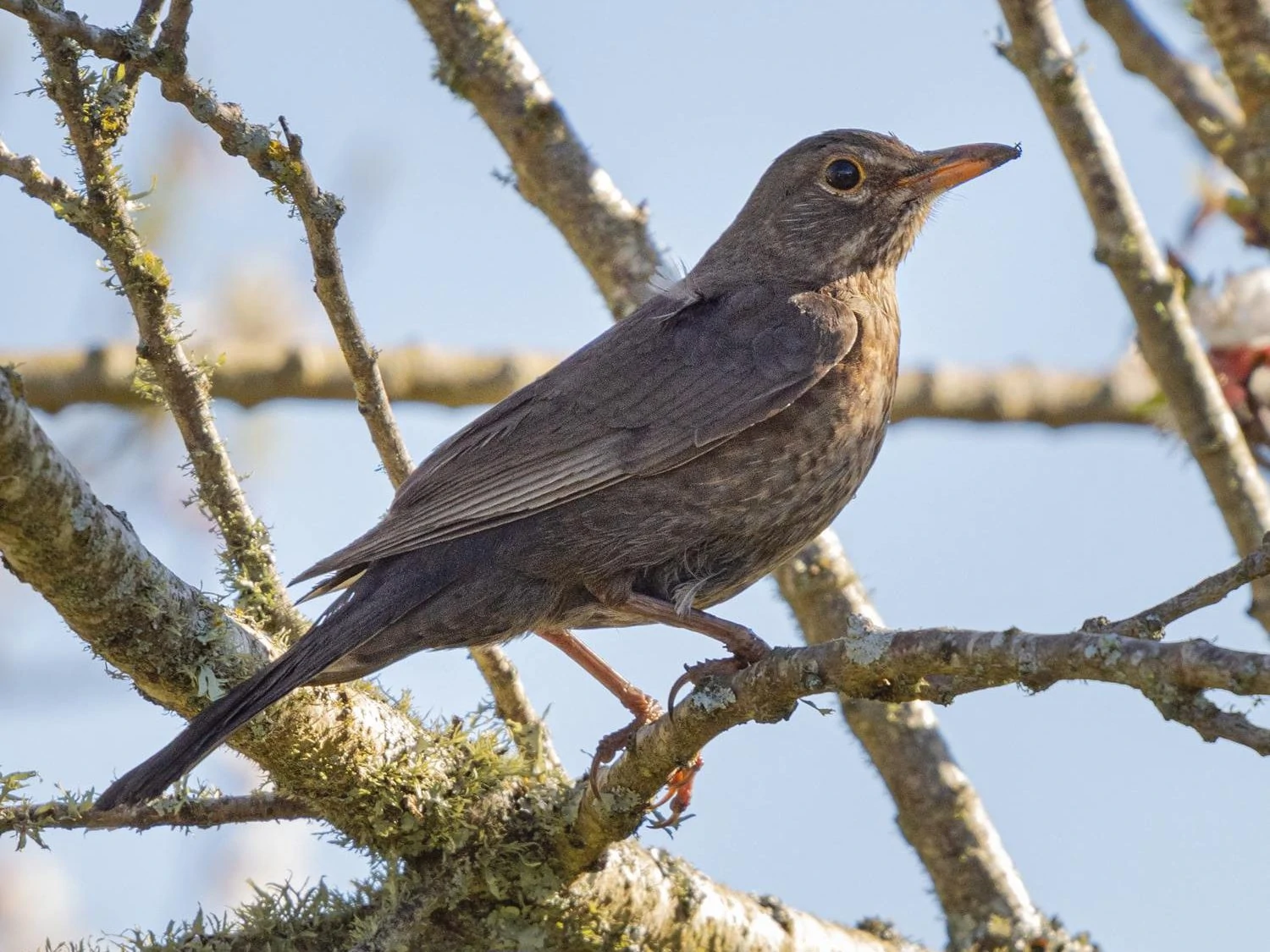
Swainson’s Thrushes spend the breeding season in Washington and occur in 18% of summer checklists. They are mainly spotted here from May to October.
Swainson’s Thrushes are brown on the back and paler undersides that are spotted brown on the throat and breast. The spotting gets lighter the further down their flanks. They are medium-sized and have distinctive eyerings if you are close enough to spot them.
- Catharus ustulatus
- Length: 6.3-7.5 in (16-19 cm)
- Weight: 0.8-1.6 oz (23-45 g)
- Wingspan: 11.4-12.2 in (29-31 cm)
Swainson’s Thrushes breed in Canada, Alaska, and some northeastern and northwestern US states. They can be seen during migration over the rest of the US when heading to or from wintering grounds in Central and South America.
You can find Swainson’s Thrushes mainly in coniferous forests in breeding grounds, but during migration, Swainson’s Thrushes are found in areas of dense undergrowth. They feed on insects and fruit.
Swainson’s Thrush song:
Attract Swainson’s Thrushes to your backyard with birdbaths on the ground, protection from trees and shrubs, and not tidying or using pesticides.
15. Red-winged Blackbird
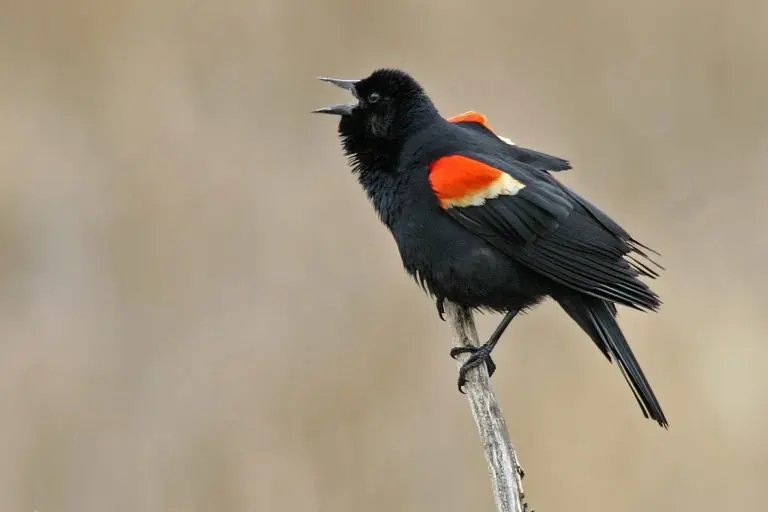
Red-winged blackbirds live in Washington all year but are mainly spotted from February to June. They appear in 28% of summer checklists and 17% of winter checklists.
Red-winged blackbirds are very common and easy to identify with the all-black coloring except for the reddish-orange wing patches. Females are rather dull in comparison with streaky brown color.
- Agelaius phoeniceus
- Length: 6.7-9.1 in (17-23 cm)
- Weight: 1.1-2.7 oz (32-77 g)
- Wingspan: 12.2-15.8 in (31-40 cm)
Red-winged Blackbirds remain all year in the lower 48 and the Pacific Coast of British Columbia. Those that breed in Canada and some northern US states migrate south for the winter.
They can often be spotted sitting on telephone wires, and the males will fiercely defend their territories in the breeding season, even attacking people that get too close to their nests. In winter, they roost in large numbers into the millions.
Red-winged Blackbird Song:
Red-winged Blackbird Calls:
Attract Red-winged blackbirds to your backyard with mixed grain and seeds spread on the ground. They will also feed from large tube feeders or platform feeders.
Blackbirds are a vast family of birds that have numerous family members, and why don’t you get to know all the blackbirds in Washington?
16. Anna’s Hummingbird
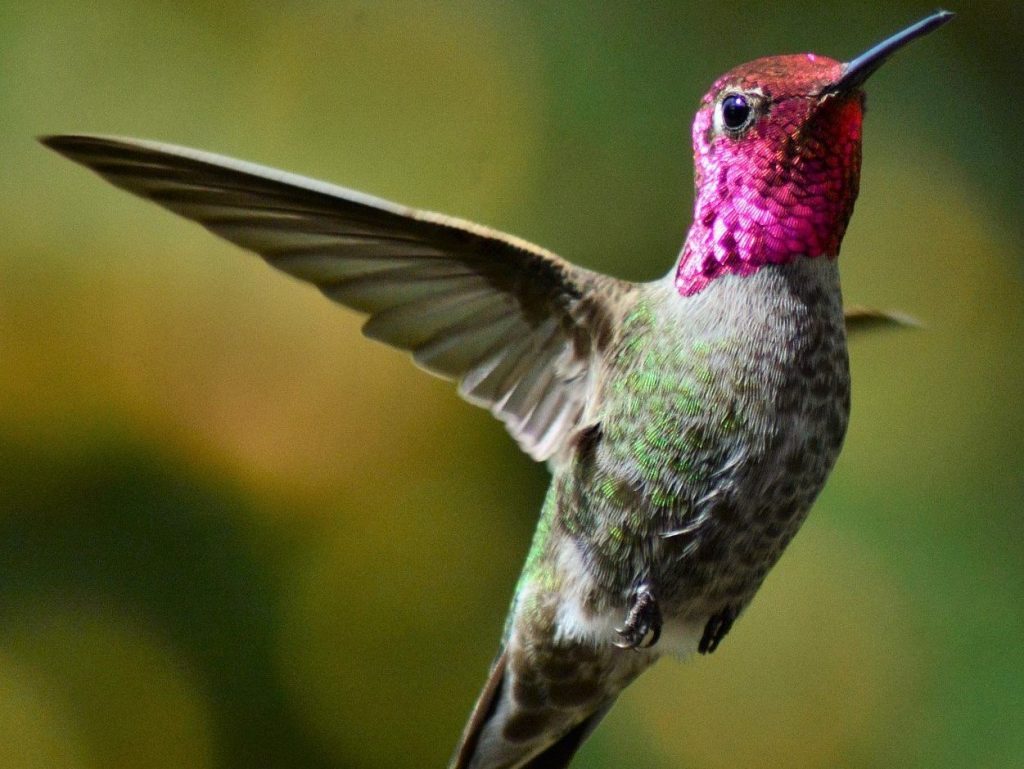
Anna’s Hummingbirds are spotted in Washington all year, mainly in the west of the state. They are recorded in 19% of summer checklists and 26% of winter checklists.
Anna’s Hummingbirds are tiny birds that are mostly green and gray. The male’s head and throat are iridescent reddish-pink, but the female’s throat is grayish with bits of red spotting.
- Calypte anna
- Length: 3.9 in (10 cm)
- Weight: 0.1-0.2 oz (3-6 g)
- Wingspan: 4.7 in (12 cm)
Unusually Anna’s Hummingbirds do not migrate, and they are the most common hummingbird along the Pacific Coast.
You can find Anna’s Hummingbirds near large colorful blossoms during the spring, and they readily visit hummingbird feeders that you can fill with homemade hummingbird nectar.
They make a dramatic dive display during courtship as the males climb up to 130 feet into the air before diving back to the ground with a burst of noise from their tail feathers.
Anna’s Hummingbird Call:
Attract Anna’s Hummingbirds to your backyard with nectar feeders and lots of colorful plants.
If you get a buzz out of hummingbirds, then check out all the hummingbirds in Washington and when is best to spot them.
17. Rufous Hummingbird
Rufous Hummingbirds are near-threatened species in Washington but can be spotted here during summer and appear in 16% of checklists at this time. They can be seen here mainly from March to September.
Rufous Hummingbirds are bright orange on the back and belly, a white patch below the throat and an iridescent red throat in the males. The females are greenish-brown on the back and rusty colored on the sides with a whitish belly.
- Length: 2.8-3.5 in (7-9 cm)
- Weight: 0.1-0.2 oz (2-5 g)
- Wingspan: 4.3 in (11 cm)
Rufous Hummingbirds are one of the longest migrating birds relative to their size, traveling up to 4000 miles each way. In the summer, they breed in northwest Alaska and northwest Canada and migrate down to Mexico and the Gulf Coast for winter.
Migration of Rufous Hummingbirds is north along the Pacific Coast in spring and the Rocky Mountains in late summer and fall. Migration in the spring of Rufous Hummingbirds starts in February, and they usually reach Alaska by mid-April. Migration in the fall is in July and August and ends by October.
A study has shown that Rufous Hummingbirds start their migration earlier and travel north more inland than before.
Rufous Hummingbird numbers have declined by around 60% since the 1970s
Rufous Hummingbirds feed primarily on nectar from colorful tubular flowers and insects such as gnats, midges, and flies. They build a nest high up in trees using soft down from plants and spider webs to hold it together. They lay 2-3 tiny white eggs about 0.5 in (1.3 cm) long. Their habitat is mountain meadows and coniferous forests.
They are very aggressive and chase off any other hummingbirds that may appear, even larger hummingbirds or resident ones during migration. They won’t hang around long during migration but will still chase off most other hummingbirds given a chance.
18. Chestnut-backed Chickadee
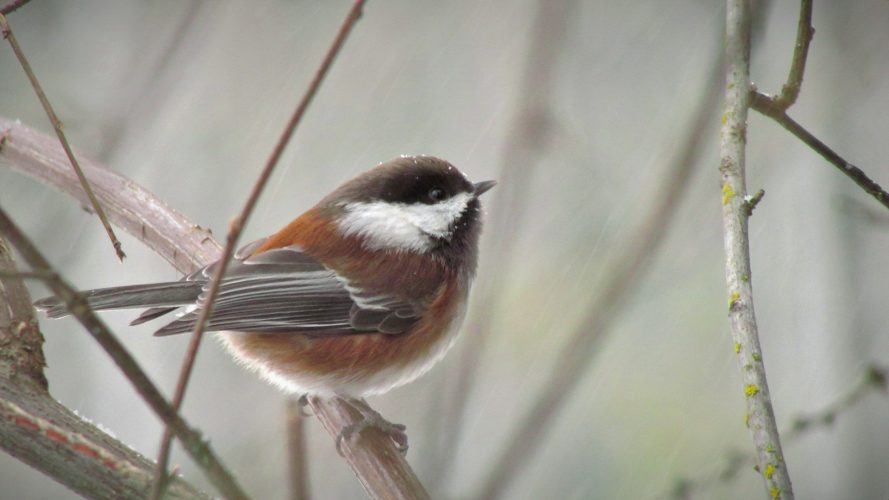
Chestnut-backed Chickadees can be spotted all year in Washington, mainly in the west and northeast of the state. They do not migrate and appear in 16% of summer checklists and 18% of winter checklists.
Chestnut-backed Chickadees are tiny birds with black caps and throats and white cheeks. They are a rich chestnut on their backs and sides and have gray wings and bellies. In California, their sides are gray instead of brown.
- Poecile rufescens
- Length: 3.9-4.7 in (10-12 cm)
- Weight: 0.3-0.4 oz (7-12 g)
- Wingspan: 7.5 in (19 cm)
Chestnut-backed Chickadees live flocks in wet evergreen forests along the Pacific Coast and are regular visitors to backyard feeders.
You can find Chestnut-backed Chickadees usually in conifer forests. They eat mostly insects, including caterpillars, spiders, wasps, and aphids, with seeds, berries, and fruit making up the rest.
Attract Chestnut-backed Chickadees to your yard with black-oil sunflower seeds, suet, nyjer, peanuts, or mealworms in tube feeders, platform feeders, or suet cages. They will also use nest boxes.
19. Steller’s Jay
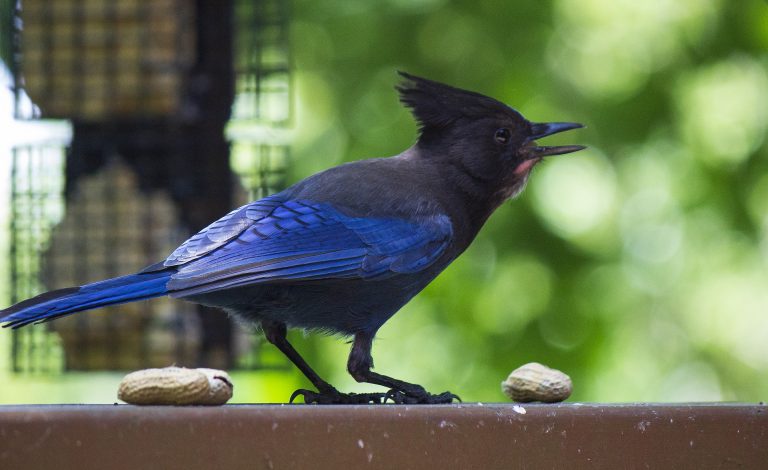
Steller’s Jays do not migrate and can be spotted in Washington all year. They are recorded in 16% of summer checklists and 18% of winter checklists for the state.
Steller’s Jays are large songbirds with black triangular crests that stick up from their heads. The rest of their heads and onto their chests and back are black, with the rest of their bodies being blue.
- Cyanocitta stelleri
- Length: 11.8-13.4 in (30-34 cm)
- Weight: 3.5-4.9 oz (100-140 g)
- Wingspan: 17.3 in (44 cm)
Steller’s Jays are resident in western US states, western Canada, Mexico, and Central America.
You can find Steller’s Jays in evergreen forests in the mountains, and they will also be found around picnic tables, campgrounds, and backyard feeders.
Steller’s Jays eat most things they can forage for, including insects, seeds, nuts, berries, eggs, and nestlings, but also making a nuisance of themselves around garbage and your unguarded picnic!
Steller’s Jay sounds: They make ‘kaw’ sounds as well as fast two-toned calls, peeps, and harsh guttural sounds. Steller’s Jays can also mimic other noises such as other bird species and even sprinklers and alarms.
Attract Steller’s Jays to your backyard with peanuts and suet.
20. Red-breasted Nuthatch
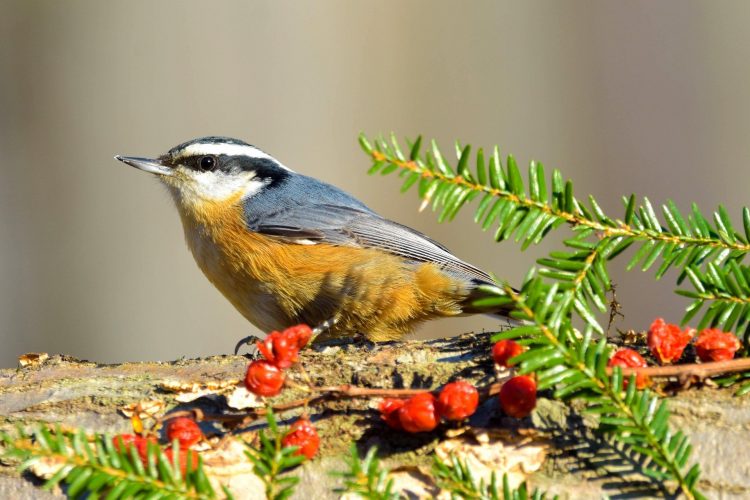
Red-breasted Nuthatches are found in Washington all year but are mainly spotted from July to September. They are recorded in 18% of summer checklists and 15% of winter checklists for the state.
Red-breasted Nuthatches are blue-gray birds with black and white stripes on their heads and a rusty underside.
- Sitta canadensis
- Length: 4.3 in (11 cm)
- Weight: 0.3-0.5 oz (8-13 g)
- Wingspan: 7.1-7.9 in (18-20 cm)
Red-breasted Nuthatches remain all year in northeastern and western states, Alaska and Canada but may move south in winter if cone crops are poor.
You can find Red-breasted Nuthatches in coniferous woods foraging for cones, and they also visit backyard feeders.
Red-breasted Nuthatch Call:
Attract Red-breasted Nuthatches to your backyard with black oil sunflower seeds, suet feeders, peanuts, and mealworms.
21. House Sparrow
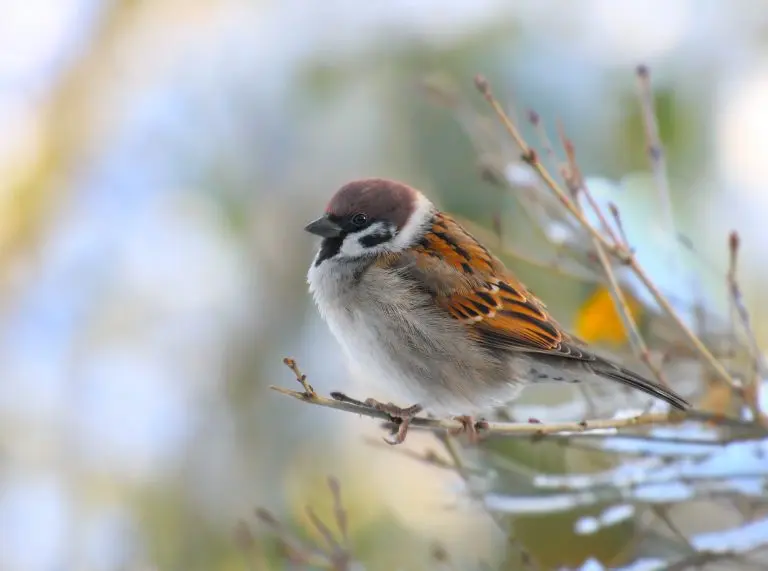
House Sparrows are an introduced species in Washington that can be spotted here all year. They do not migrate and occur in 15% of summer checklists and 13% of winter checklists for the state.
The House Sparrow is another introduced species that has done very well and is now one of the most common birds. They have gray and brown heads and white cheeks. Their backs are black and brown, and their bellies are gray.
- Passer domesticus
- Length: 5.9-6.7 in (15-17 cm)
- Weight: 0.9-1.1 oz (27-30 g)
- Wingspan: 7.5-9.8 in (19-25 cm)
House Sparrows live in the US and Southern Canada all year.
You can find them near houses and buildings, and they can be pretty tame, and they may even eat out of your hand.
House Sparrows eat mostly grain and seed as well as discarded food. They can be considered a pest because they are non-native, but they are found in backyards even if you do not feed them.
House Sparrow Song:
Attract House Sparrows to your backyard feeders with most kinds of birdseed, including millet, corn, and sunflower seeds.
Brown birds are often overlooked but once you get to know a few you are hooked so get studying all the brown birds in Washington.
22. Yellow-rumped Warbler
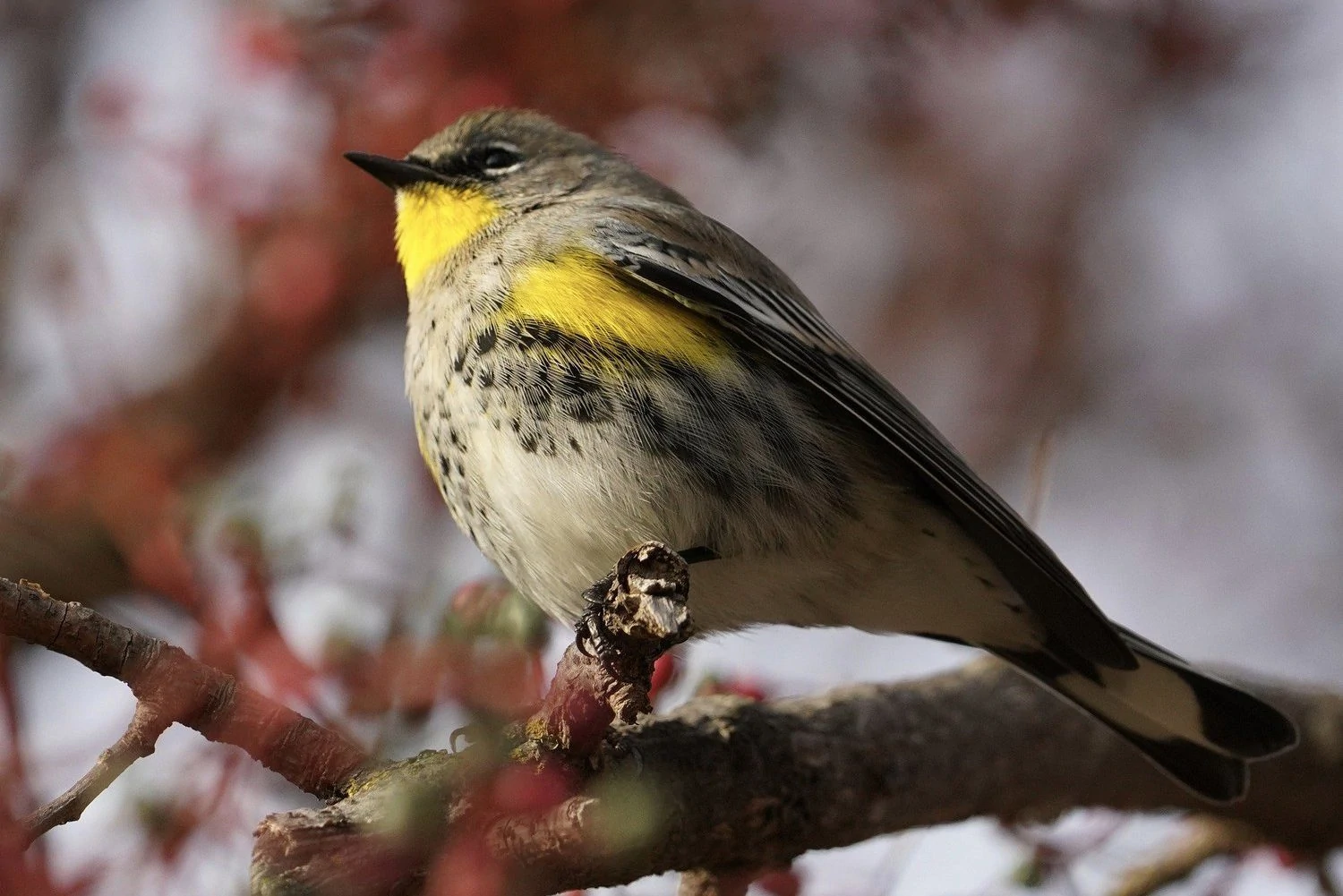
Yellow-rumped Warblers can be spotted all year in Washington, but their numbers increase during the migration from March to May and from September to October.
They are recorded in 11% of summer checklists, 6% of winter checklists, and up to 38% of checklists during migration.
Yellow-rumped Warblers are gray with flashes of yellow on the face, sides, and rump and white in the wings.
Females may be slightly brown, and winter birds are paler brown with bright yellow rumps and sides turning bright yellow and gray again in spring.
- Setophaga coronata
- Length: 4.7-5.5 in (12-14 cm)
- Weight: 0.4-0.5 oz (12-13 g)
- Wingspan: 7.5-9.1 in (19-23 cm)
Yellow-rumped Warblers breed predominantly in Canada and parts of the Rockies and the Appalachian mountains.
During migration, they can be seen in the Midwest before overwintering in southern and southwestern US states and the Pacific Coast and into Mexico and Central America.
You can find Yellow-rumped Warblers in coniferous forests, especially during the breeding season. During winter, they can be found in open areas with fruiting shrubs. In summer, they eat mostly insects and on migration, and in winter, they eat mostly fruit, including bayberry and wax myrtle.
Yellow-rumped Warbler Song:
Attract Yellow-rumped Warblers to your backyard with sunflower seeds, suet, raisins, and peanut butter.
These colorful and melodious migratory birds don’t stick around for long so be sure to check out all the warblers in Washington you can spot before it’s too late.
23. Pine Siskin
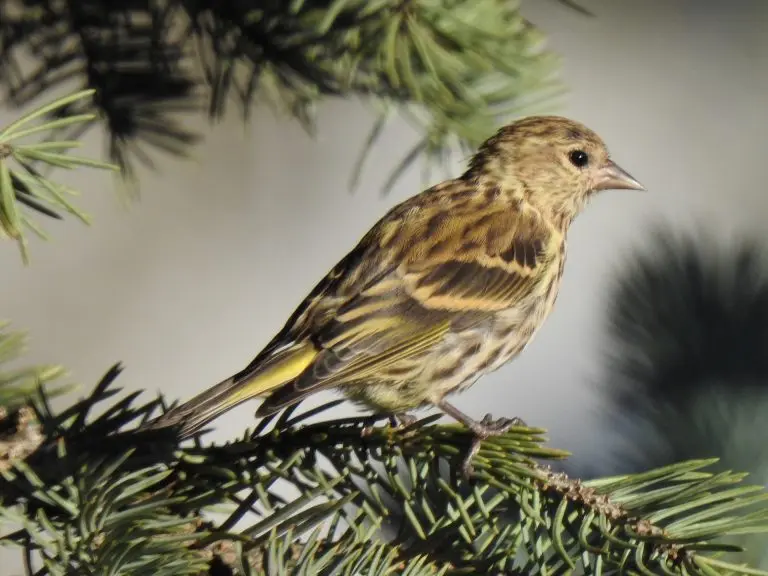
Pine Siskins can be spotted in Washington all year. They appear in 12% of summer and winter checklists for the state.
Pine Siskins are small brown finches with yellow streaks on the wing and tail. They have a forked tail and pointed wings, with a short pointed bill.
- Spinus Pinus
- Length: 4.3-5.5 in (11-14 cm)
- Weight: 0.4-0.6 oz (12-18 g)
- Wingspan: 7.1-8.7 in (18-22 cm)
Pine Siskins remain all year in the pine forests in the western states and along the Canadian Border. Some also breed in Canada before heading south for winter.
Depending on pine cone crops, they can be found over much of North America. As their name suggests, Pine Siskins predominantly eat seeds from conifers, but they also eat young buds and seeds from grasses and weeds.
Pine Siskin Song:
Attract Pine Siskins to your backyards with thistle and nyjer feeders but also black oil sunflower seeds and suet.
24. Golden-crowned Kinglet
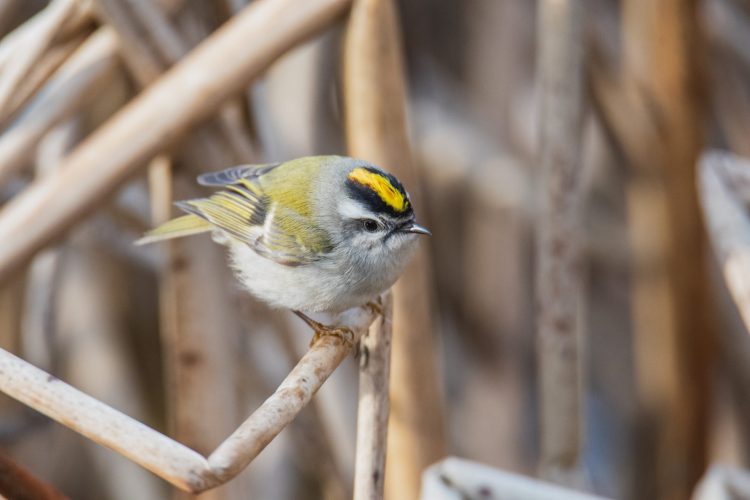
Golden-crowned Kinglets are spotted in western Washington all year, but they are more common during winter from September to March in the east of the state. They appear in 6% of summer checklists and 13% of winter checklists.
Golden-crowned Kinglets are tiny songbirds with a bright orange crown patch that can be lifted and flashed when excited. Their bodies are olive on the back and pale underneath and with a black-and-white striped face and a white wingbar.
- Corthylio calendula
- Length: 3.5-4.3 in (9-11 cm)
- Weight: 0.2-0.3 oz (5-10 g)
- Wingspan: 6.3-7.1 in (16-18 cm)
Golden-crowned Kinglets that breed in Canada move south across the U.S. Some stay all year in the Appalachians and the mountainous West or Pacific Coast.
You can find Golden-crowned Kinglets in many habitats from forests, parks, backyards, and old fields, swamps, and cities. Their diet is mainly insects, and in winter, they also eat seeds.
Golden-crowned Kinglets song:
Attract Golden-crowned Kinglets by planting native plants that encourage lots of insects and suet feeders.
25. Golden-crowned Sparrow
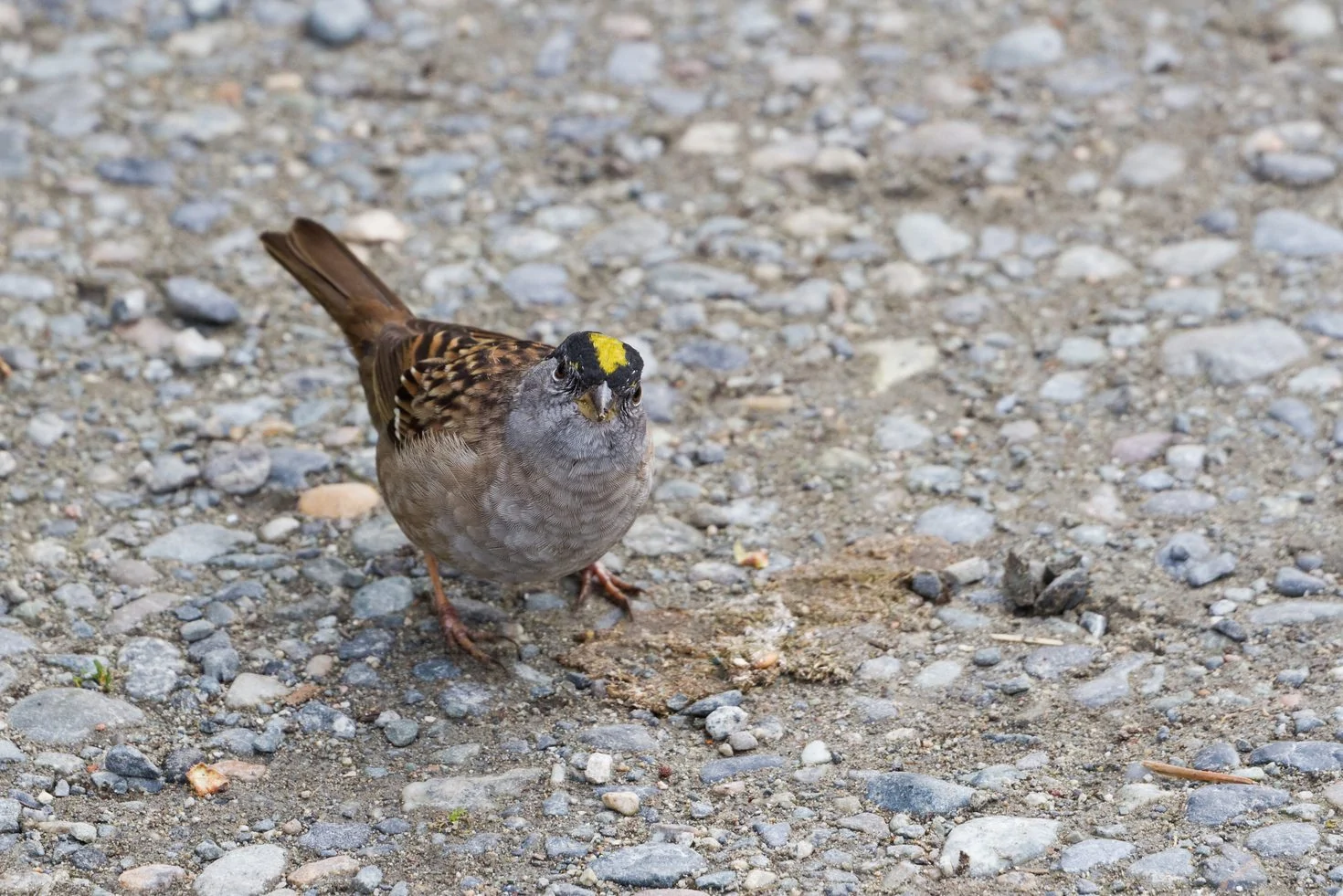
Golden-crowned Sparrows can be found in Washington during winter, mainly from September to May, but their numbers increase during the spring and fall migration. They appear in 16% of checklists during winter and up to 21% of checklists during the migration.
Golden-crowned Sparrows are grayish-brown underneath and streaked brown on the back. Their heads have a black crown and a bright-yellow forehead.
The colors are duller and brown on the crown in winter, and the yellow forehead is also duller.
- Zonotrichia atricapilla
- Length: 5.9-7.1 in (15-18 cm)
- Weight: 1.1-1.2 oz (30-33 g)
Golden-crowned Sparrows breed in Alaska and western Canada before migrating to the West Coast for winter.
You can find Golden-crowned Sparrow in weedy fields scratching for seeds such as dock, sumac, and geranium. They also eat fruit such as apples, grapes, elderberry, and olives. Insects also make up some of their diets, such as ants, beetles, butterflies, and termites.
Golden-crowned Sparrows sounds: Their song is a sad, slow series of whistles that decrease in pitch.
Attract Golden-crowned Sparrows to your backyard with seeds on ground feeders or plant native plants that fruit.
26. Downy Woodpecker
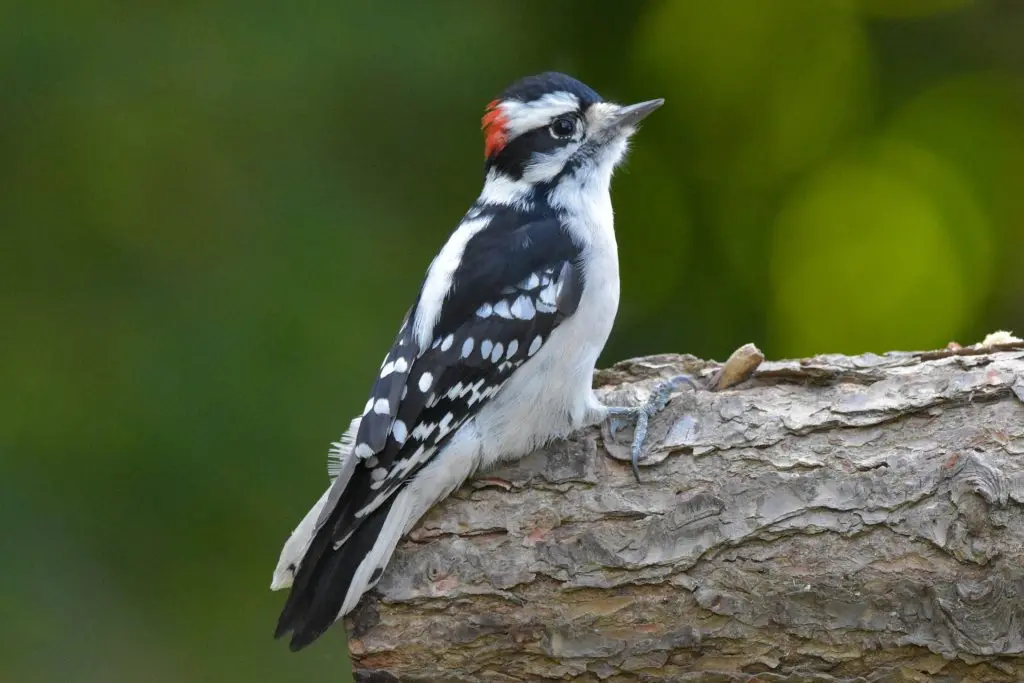
Downy Woodpeckers do not migrate and are residents of Washington all year. They appear in 9% of summer checklists and 11% of winter checklists.
Downy Woodpeckers are small birds that are common at backyard feeders. They are often mixed in with other birds, such as chickadees and nuthatches.
They have black and white coloring with a red patch at the back of their heads. They look similar to the Hairy Woodpecker but smaller.
- Dryobates pubescens
- Length: 5.5-6.7 in (14-17 cm)
- Weight: 0.7-1.0 oz (21-28 g)
- Wingspan: 9.8-11.8 in (25-30 cm)
Downy Woodpeckers do not migrate and can be spotted in most states and provinces, except the north of Canada.
You can find Downy woodpeckers in woodlots, along streams, city parks, and backyards, and they eat mainly insects and beetle larvae but also berries, acorns, and grains.
Downy Woodpecker Call:
Attract Downy Woodpeckers to your backyard with their favorite treat of suet, but they will also eat black oil sunflower seeds, millet, and peanuts on platform feeders.
Some woodpeckers are more easily recognized than others, but with this guide, you can identify all the woodpeckers in Washington.
27. Mourning Dove
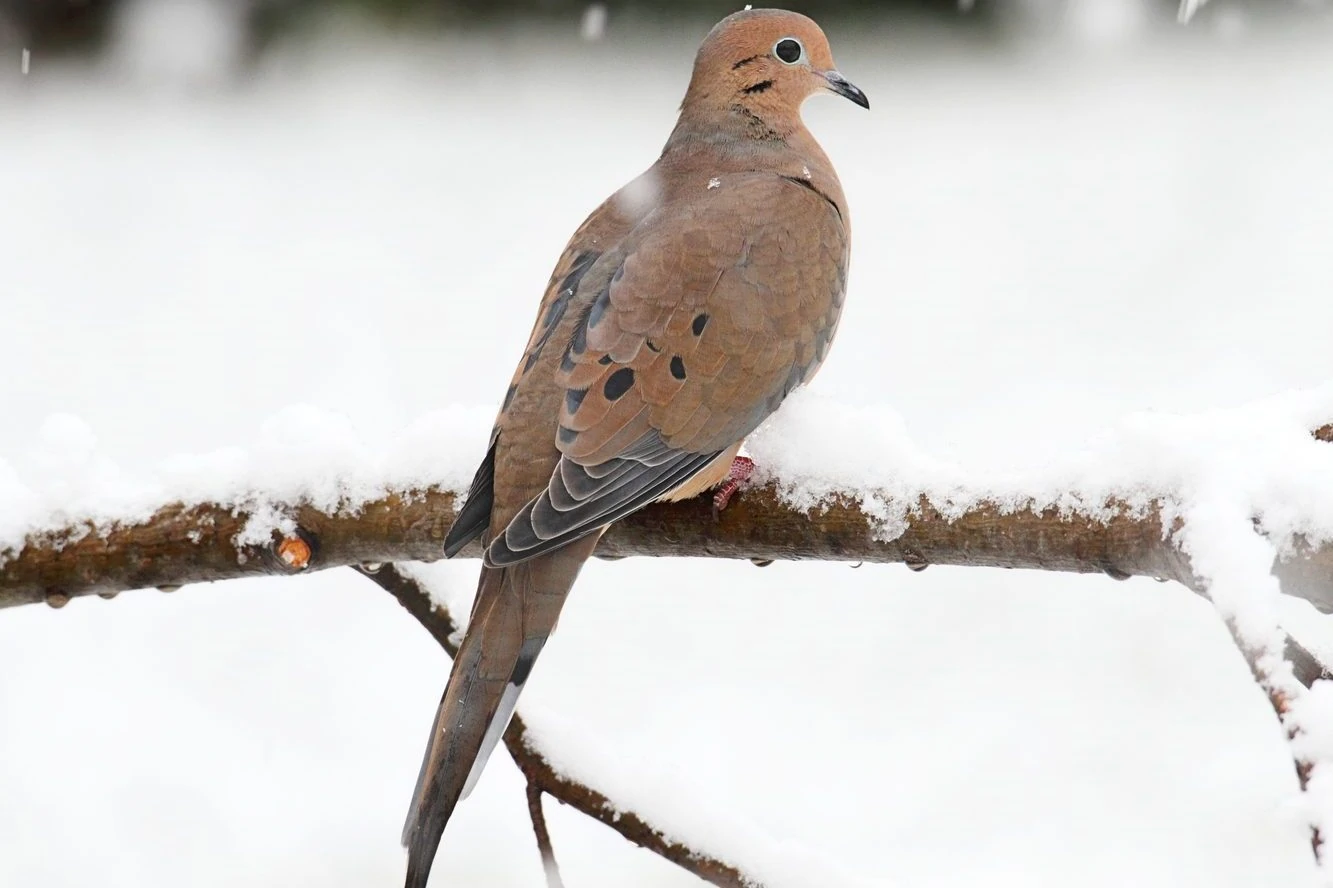
Mourning Doves are spotted all year in Washington but are more common from April to September. They occur in 16% of summer checklists and 5% of winter checklists.
Mourning Doves are graceful small-headed birds with plump bodies and long tails. They are a soft brown color with black spots on the wings. Males are slightly heavier than females.
- Zenaida macroura
- Length: 9.1-13.4 in (23-34 cm)
- Weight: 3.0 -6.0 oz (96-170 g)
- Wingspan: 17.7 in (45 cm)
Mourning Doves are common over all of the lower 48 all year but may migrate after breeding from the north of the Midwest and southern Canada.
Mourning Doves can be seen perching on telephone wires and foraging for seeds on the ground in grasslands, fields, and backyards. They can also be found in open areas or woodland edges.
Mourning Dove call:
Attract Mourning Doves to your backyard by scattering millet on the ground or platform feeders. They will also eat black sunflower seeds, nyjer, cracked corn, and peanut hearts.
28. Ruby-crowned Kinglet
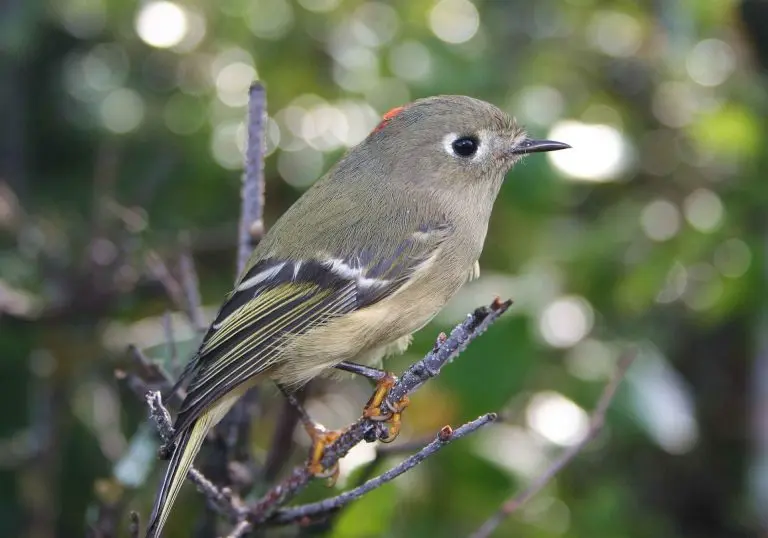
Ruby-crowned Kinglets are more common in Washington during winter and occur in 14% of checklists at this time. However, some also stay all year.
Ruby-crowned Kinglets are small songbirds that are olive-green, and the males have a brilliant red crown that is usually flat, so hard to see.
- Corthylio calendula
- Length: 3.5-4.3 in (9-11 cm)
- Weight: 0.2-0.3 oz (5-10 g)
- Wingspan: 6.3-7.1 in (16-18 cm)
Ruby-crowned Kinglets breed in Canada and the mountainous west before migrating to southern and southwestern US states and Mexico for the winter.
Ruby-crowned Kinglets can be hard to spot as they are fast-moving quiet birds that flit around in the foliage of lower branches and shrubs and trees looking for spiders and insects.
Ruby-crowned Kinglet Song:
Attract Ruby-crowned Kinglets with suet or platform feeders with hulled sunflower seeds, peanut hearts, and mealworms.
29. Eurasian Collared-Dove
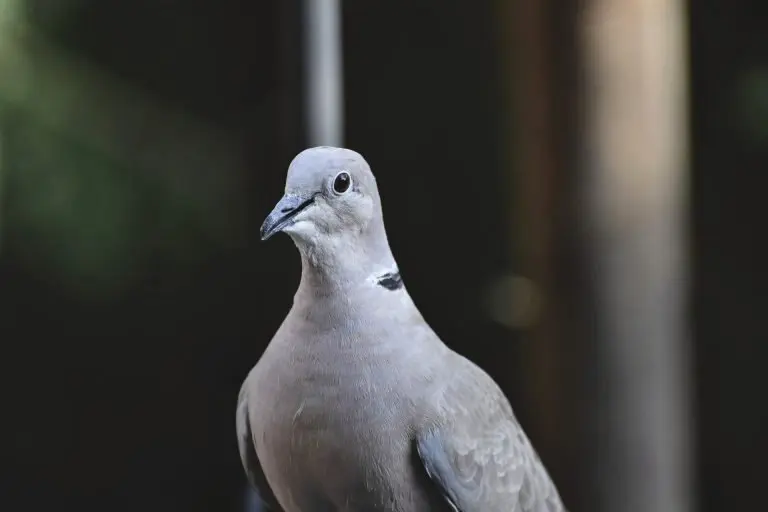
Eurasian Collared-Doves are residents all year in Washington but are mainly spotted from April to September. They are recorded in 11% of summer checklists and 7% of winter checklists.
Eurasian-collard Doves are light brownish-gray, with white patches in the tail, and look very similar to Mourning Doves, but with a black half collar at the nape of the neck. They are also larger and with a square tail rather than pointed.
- Streptopelia decaocto
- Length: 11.4-11.8 in (29-30 cm)
- Weight: 4.9-6.3 oz (140-180 g)
- Wingspan: 13.8 in (35 cm)
Eurasian Collared-Doves are an introduced species that only arrived in the 1980s but now live across most of the United States.
You can find Eurasian Collared-Doves in most areas, including rural and suburban and they eat a wide variety of seeds and grain but also eat some berries and insects.
Eurasian Collared-Dove song:
30. Purple Finch
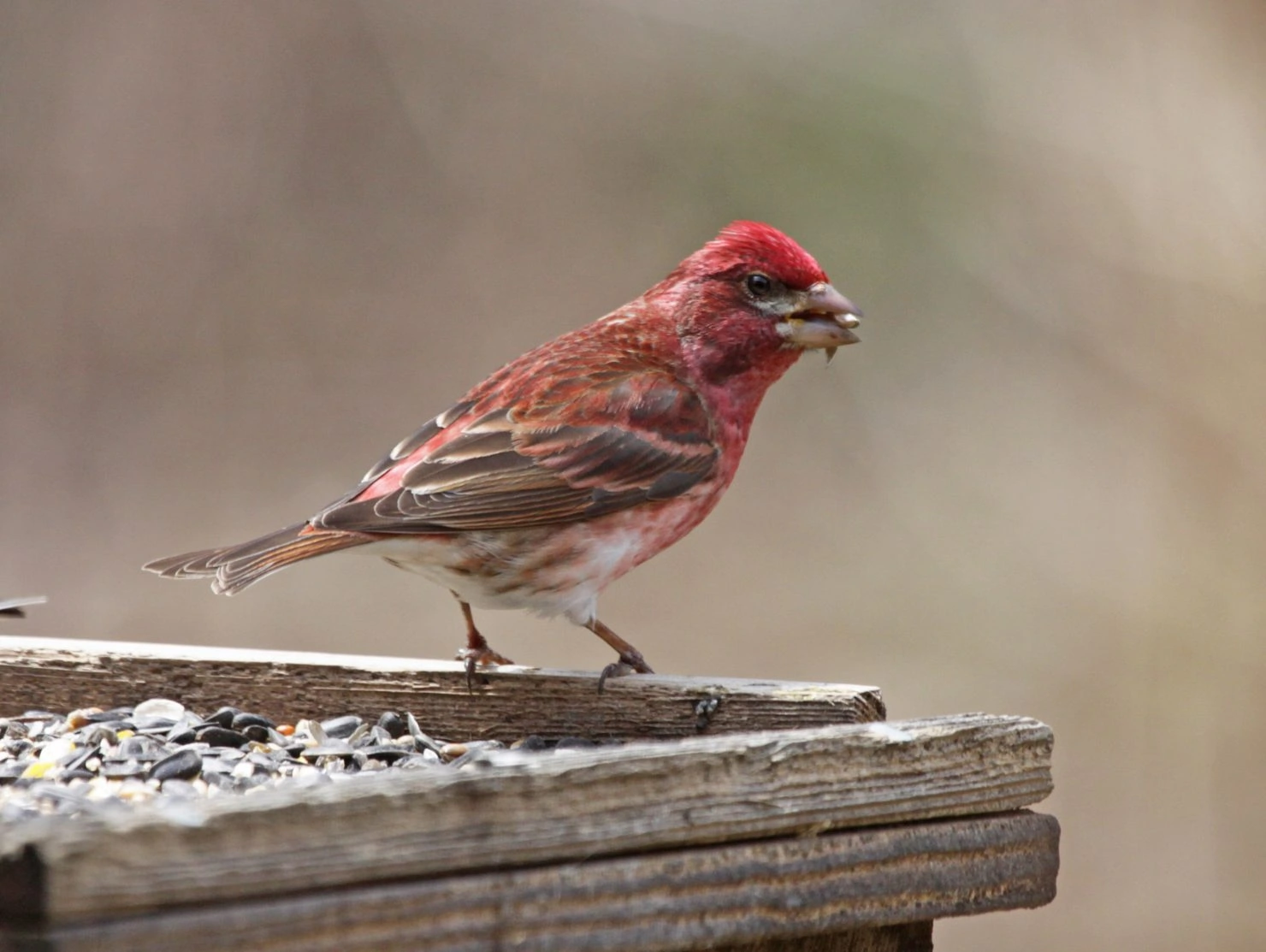
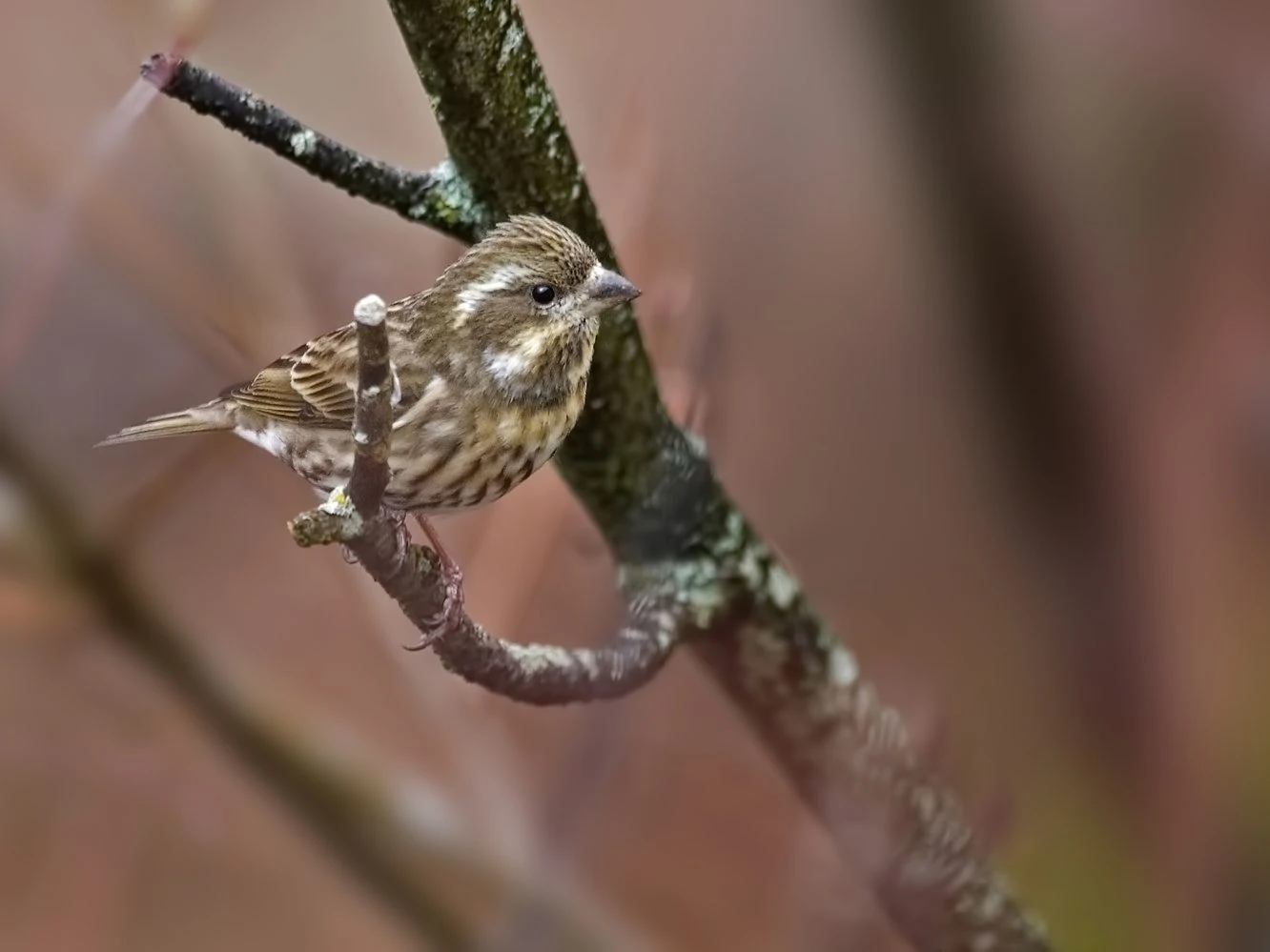
Purple Finches are spotted in western Washington mainly during the breeding season, but some also stay all year. They are recorded in 10% of summer checklists and 3% of winter checklists.
Purple Finches males have reddish-purple heads and breasts with more brown on the back and wings, and they have a paler belly. Females are brown-streaked all over. They look very similar to House Finch but are redder, especially at the top of their back.
- Haemorhous purpureus
- Length: 4.7-6.3 in (12-16 cm)
- Weight: 0.6-1.1 oz (18-32 g)
- Wingspan: 8.7-10.2 in (22-26 cm)
Purple Finches breed in Canada and overwinter in eastern states but can be found all year in the north-east and Pacific coast.
You can find Purple Finch in evergreen forests feeding on seeds but also buds, nectar, and berries.
Purple Finch Song:
Attract Purple Finches to your backyards with black oil sunflower seeds.
There are a surprising number of finches in Washington that you can get to know.
31. Common Yellowthroat
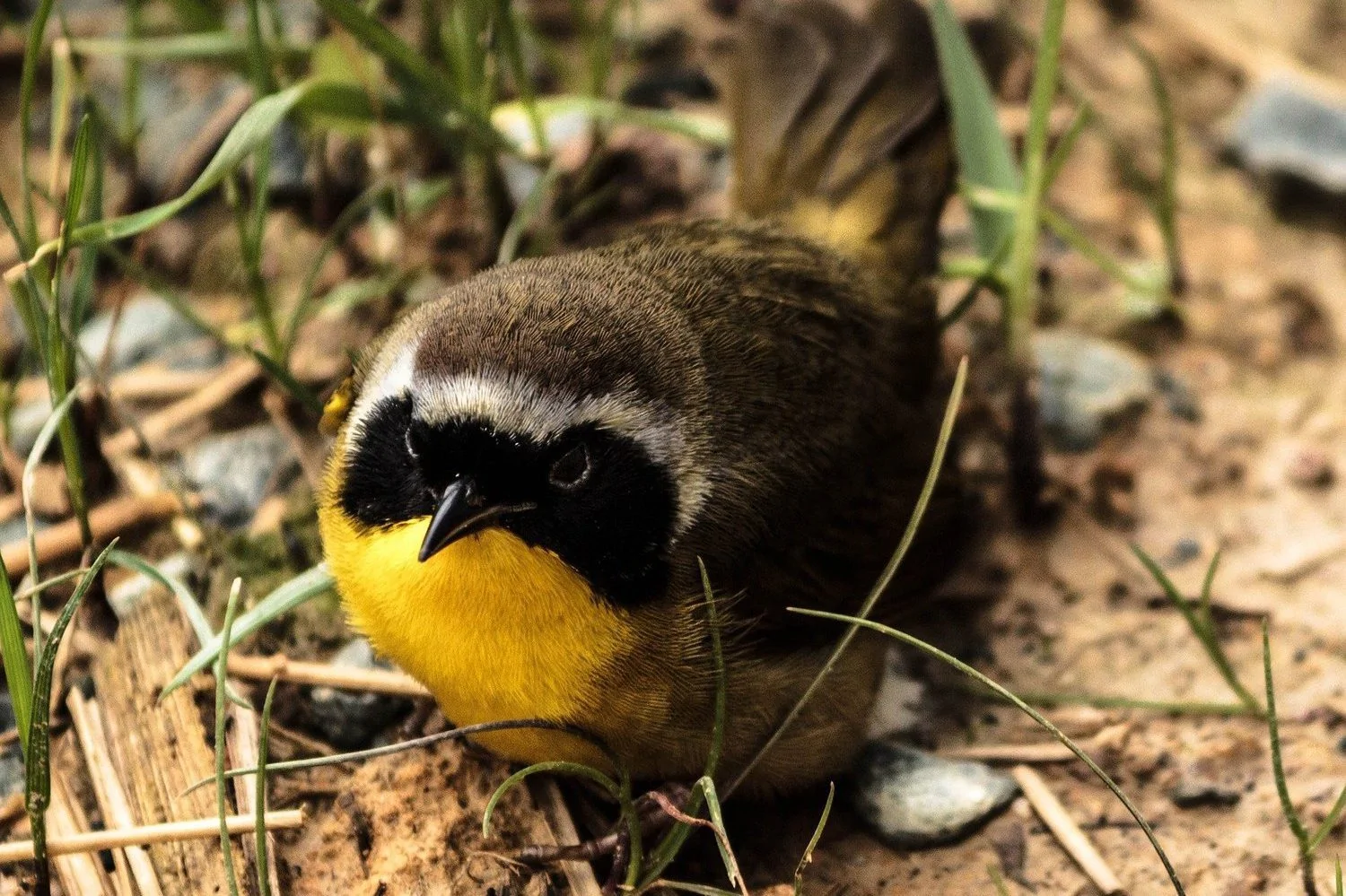
Common Yellowthroats spend the breeding season in Washington and are mainly spotted from April to October. They appear in 14% of summer checklists.
Common Yellowthroats are small songbirds that are brownish on the back and bright yellow underneath, with long tails. The males have a black masks across their faces. The brightness of the yellow can vary geographically, and they may be more olive in parts underneath.
- Geothlypis trichas
- Length: 4.3-5.1 in (11-13 cm)
- Weight: 0.3-0.3 oz (9-10 g)
- Wingspan: 5.9-7.5 in (15-19 cm)
Common Yellowthroats spend the summer breeding over most of North America, except Alaska and northern Canada. Some remain all year along the Gulf Coast and Pacific Southwest. Then, they migrate south for winter.
You can find Common Yellowthroats often in marshy or wetland areas and brushy fields living in thick, tangled vegetation.
Common Yellowthroat Song:
Attract Common Yellowthroats to large backyards with dense vegetation and native plants to attract insects.
32. Hairy Woodpecker
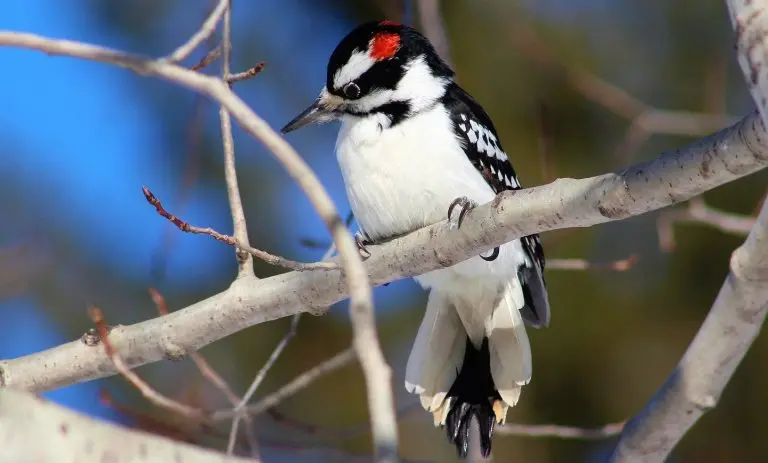
Hairy Woodpeckers are spotted in Washington all year but are more common from May to September. They appear in 6% of summer checklists and 4% of winter checklists.
Hairy Woodpeckers are medium-sized woodpeckers with a black and white pattern and a large white patch on their backs. The males have a flash of red towards the back of their heads.
They are visually similar to Downy Woodpeckers but larger and with longer bills. As they are often found in the same areas, it is hard to tell them apart if they are not near each other.
- Dryobates villosus
- Length: 7.1-10.2 in (18-26 cm)
- Weight: 1.4-3.4 oz (40-95 g)
- Wingspan: 13.0-16.1 in (33-41 cm)
Hairy Woodpeckers do not migrate and live in all US states and Canada, except the far north of Canada.
You can find Hairy Woodpeckers in woodlands on trunks or main branches of large trees, but they are also found in a wide variety of habitats, including woodlots, parks, and cemeteries. Hairy Woodpeckers’ diet is mostly insects.
Hairy Woodpecker Call/drumming:
Attract Hairy Woodpeckers to your backyard with suet feeders.
Common Birds In Washington In Different Seasons
Common birds in Washington all year
American Robin 45%
Song Sparrow 43%
American Crow 36%
Dark-eyed Junco 36%
Black-capped Chickadee 35%
Northern Flicker 32%
Spotted Towhee 31%
European Starling 30%
House Finch 25%
Red-winged Blackbird 22%
Summer birds Washington
American Robin 59%
Song Sparrow 43%
American Crow 35%
Spotted Towhee 33%
American Goldfinch 32%
Black-capped Chickadee 31%
Barn Swallow 30%
Dark-eyed Junco 29%
European Starling 28%
Northern Flicker 27%
Winter birds Washington
Song Sparrow 45%
Dark-eyed Junco 43%
Black-capped Chickadee 37%
American Crow 35%
Northern Flicker 32%
American Robin 30%
Spotted Towhee 30%
European Starling 28%
House Finch 24%
Anna’s Hummingbird 22%
Best Bird Feeders to Attract Birds in Washington
A variety of different bird feeders will attract the most species of birds
- Tube Feeders can be filled with different types of birdseed and depending on the seed different birds will be attracted. Black oil sunflower seeds attract Goldfinches, Chickadees, Woodpeckers, Nuthatches, and Pine Siskins.
- Ground Feeders or a tray below a Tube Feeder with Black oil sunflowers tube feeders attract Cardinals, Jays, Finches, and Sparrows.
- Platform feeders with Millet or Corn attract small and medium-sized birds such as sparrows, Blackbirds, Towhees, Juncos, Doves, Grackles, and Starlings.
- Peanut feeders attract Woodpeckers, Chickadees, Nuthatches, Titmice, Jays, Juncos, Finches, and Sparrows.
- Suet Feeders are great, especially in winter, for Woodpeckers, Cardinals, Nuthatches, Kinglets, Wrens, and Chickadees.
- Hummingbird feeders attract these tiny fascinating birds but they also attract other birds too.
How to Attract Birds to Your Yard in Washington
If you would like to attract more birds to your yard in Washington, here are some tips
- Provide bird feeders for different types of birds to get the most species to visit your yard.
- Provide a water feature such as a birdbath fountain or stream. Ensure that the water is clean and not stagnant
- Grow native plants that will provide food and shelter. Plants, trees, and shrubs that provide fruit, berries, and nuts. Blackberries, wild grasses, elderberries, serviceberries, Oaks, Beeches, Cherries, sumacs, hemlocks, Purple Coneflowers, Sunflowers, Milkweed, Cardinal Flowers, Trumpet Honeysuckle, Virginia Creeper, Buttonbush, and Dogwoods.
- Let your grass grow long to provide cover and seeds.
- Leave a brush pile to provide food, protection, and nesting opportunities for birds.
- Don’t use pesticides and herbicides as these may be toxic to birds and prevent the natural foraging opportunities for insects and seeds that birds will seek in your yard.
- Set up nest boxes to attract breeding birds and ensure they are cleaned every year.
How to Identify Birds in Washington
Here are some tips to help you identify birds:
- Size – Size is the easiest thing to notice about a bird. Birds are often measured in inches or centimeters in guide books. It’s best to take a note of the bird in terms of small, medium, or large to be able to look for it later. A small bird is about the size of a sparrow, a medium bird is about the size of a pigeon and a large bird is the size of a goose.
- Shape – Take note of the silhouette of the bird and jot it down or draw the outline. Look at tail length, bill shape, wing shape, and overall body shape.
- Color pattern – Take a note of the main color of the head, back, belly, and wings, and tail for the main color and then any secondary colors or patterns. Also take note of any patterns such as banding, spots, or highlights.
- Behavior – Are they on the ground or high up in the trees. Are they in flocks or on their own? Can you spot what they are eating?
- Habitat – Woodlands, parks, shrubs, grasslands or meadows, shore or marsh.
- Use a bird identification app such as those created by ebird or Audubon
Birds to Spot if Out Birding in Washington
If you go out Birding in Washington, these are other birds that you may be able to spot:
- Mallard
- Canada Goose
- Great Blue Heron
- Bald Eagle
- Glaucous-winged Gull
- Red-tailed Hawk
- Double-crested Cormorant
- Bufflehead
- Common Raven
- Killdeer
- Violet-green Swallow
- Belted Kingfisher
- Green-winged Teal
- Pied-billed Grebe
- Common Goldeneye
- Northern Harrier
- Northern Shoveler
- Osprey
- Americal Kestrel
- California Quail
- Pelagic Cormorant
- Turkey Vulture
- Gray-crowned Rosy-finch
- White-tailed Ptarmigan
- Short-eared Owl
- Tufted Puffin
- Western Tanager
- Harlequin Ducks
- Brown Pelicans
- Sandhill Crane

